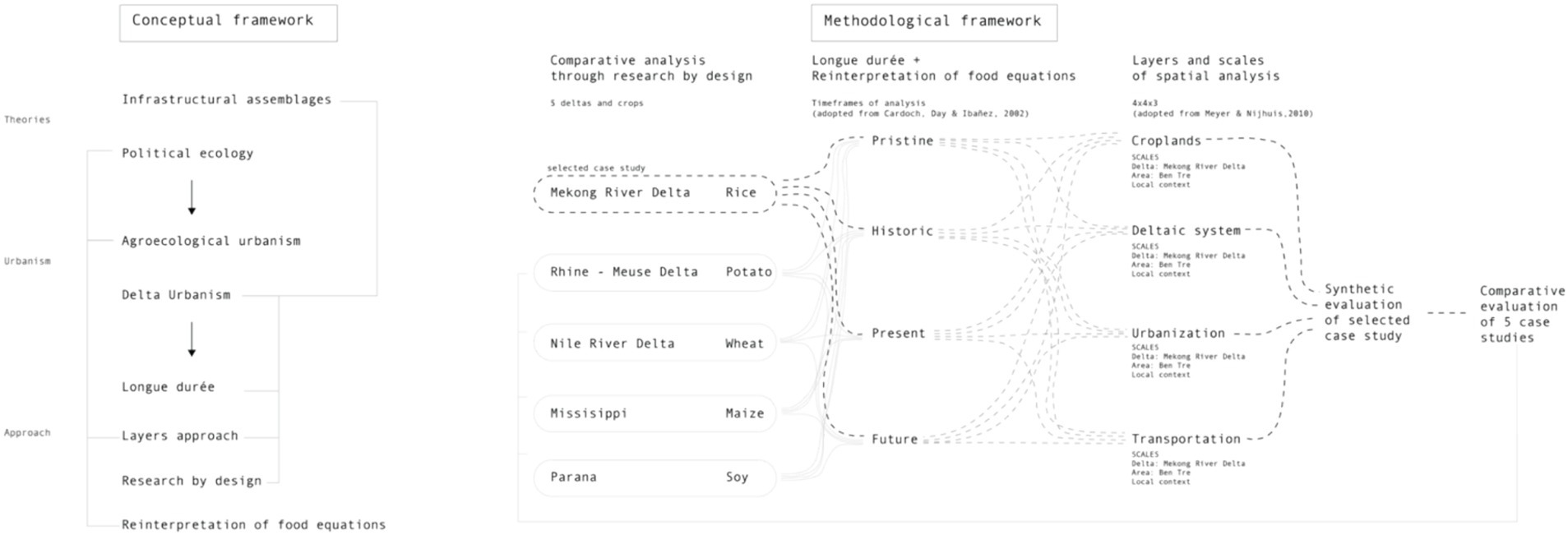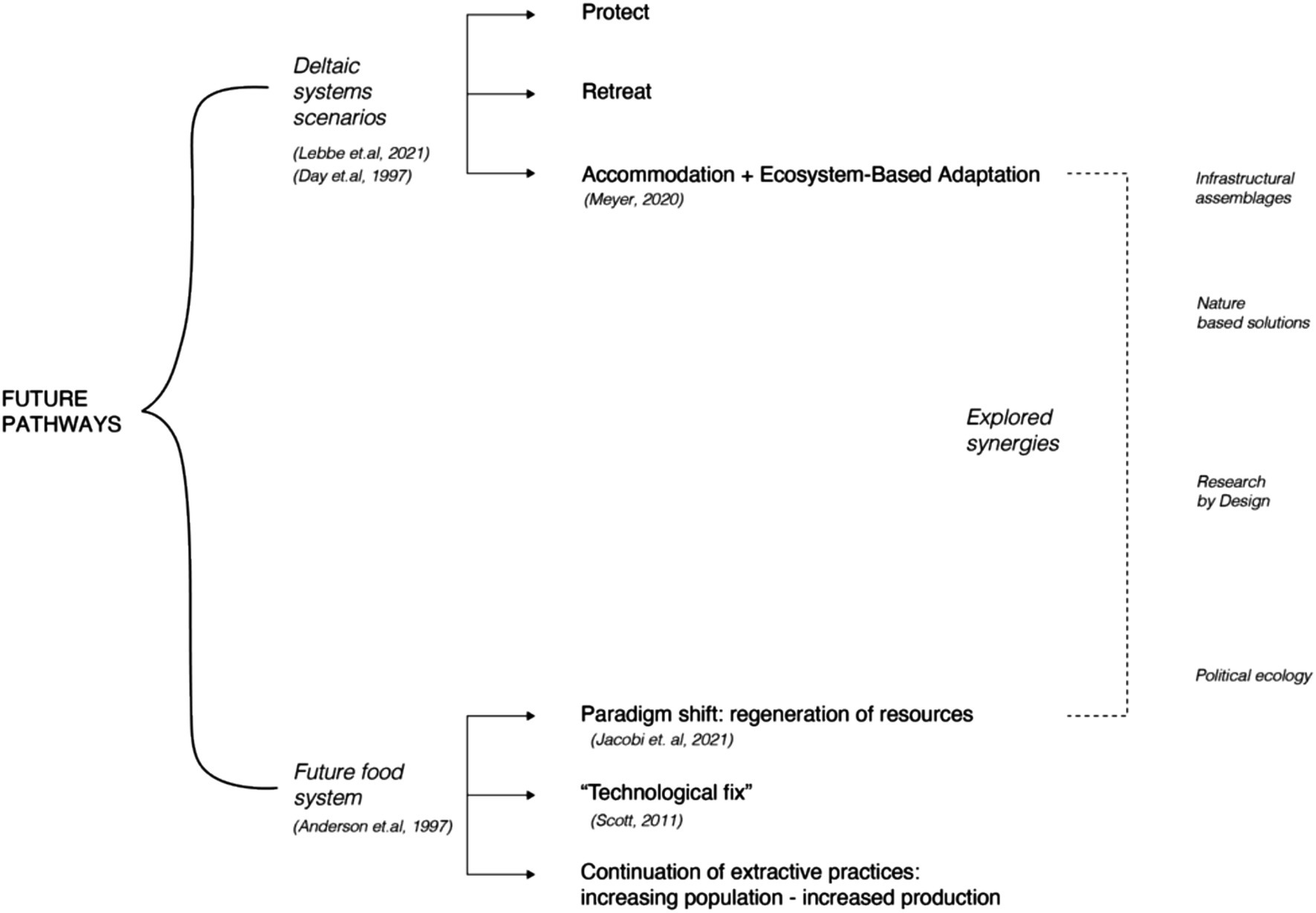- Department of Urbanism, Section Environmental Technology and Design, Delft University of Technology, TU Delft, Delft, Netherlands
Food and deltaic systems are complex, interlinked systems that are crucial for future sustainable development. This study explores the synergy between these two systems to establish an agroecological framework for delta urbanism. Drawing on political ecology approaches and the infrastructural turn, this study critically revisits food systems to understand how they can be better integrated with hydrological, infrastructural, and urban–rural processes. It also addresses fundamental questions necessary for creating new pathways and redesigning deltaic areas. Second, it examines both past and future models of food equations in relation to the deltaic landscape. Finally, it proposes a spatial framework based on a layered approach that aims to provide an analytical framework for research and design related to deltas and food across various scales and historical timeframes. The operational basis for presenting this methodology is the case of the Mekong River Delta and its rice cultivation territories. Findings emphasize the significance of technological milestones and their spatial implications in shaping resource availability, population growth, and climate change. Further application and operationalization of this framework will provide a deeper understanding of the complex interactions among food production, environmental change, and socioeconomic structures, providing valuable insights into sustainable agricultural practices and climate adaptation.
1 Introduction
Deltas are low-lying, dynamic landforms that have played a key role in agricultural and aquacultural development for millennia (Higgins et al., 2013). Their water corridors facilitate transport networks, and their rich biodiversity, along with flat topography, provides suitable ground for high productivity in agriculture, creating fertile conditions for civilizations to flourish (Barthel et al., 2019; Day et al., 1997). Currently, deltaic areas across the world serve as food baskets for important crops and are vital to food security. Asian mega deltas, such as the Ganges-Brahmaputra Delta, the Ayeyarwady Delta, and the Mekong River Delta, rank among the most important rice producers worldwide (Schneider and Asch, 2020). The Netherlands, located at the Rhine-Meuse Delta, and US deltas, such as the Mississippi River Delta, are highly productive landscapes, with both countries leading in agricultural exports. In the Netherlands, virtually the entire country is influenced by the dynamics of the delta, and despite being a small country (0.07% of the size of Russia), it is the second-largest agricultural exporter globally and the largest exporter of potatoes (The Observatory of Economic Complexity, 2024).
Deltas and food have a delicate yet intense relationship shaped by climate change. They face several significant challenges: food production leaves lasting environmental imprints that strongly impact deltas, deltas must adapt to urgent socio-environmental issues, and food systems require comprehensive reconsideration. This study argues that these processes cannot occur independently, as food and deltaic systems are highly dynamic, interconnected, and complex. It aims to establish a conceptual and methodological framework to spatially explore these two systems in relation to one another.
Food systems are no longer sustainable at various levels. Despite an advanced food supply chain, about one-third of the edible portion of food production ends up as waste or is lost throughout the food chain (Cederberg and Sonesson, 2011). At the same time, the paradox of sufficient food production coexists with undernourished communities and food insecurity (Gladek et al., 2017). Furthermore, agricultural activities drive deforestation, pollution, and the depletion of ecosystem resources and are largely dependent on non-renewable fossil fuels (Pfeiffer, 2006). Although they are inherently connected to the territories in which they operate, food systems—including water cycles and ecosystem balance—have become detached from natural cycles. This detachment is particularly evident in delta dynamics, where extensive alterations to the deltaic environment, primarily made to enhance, protect, or create land for agricultural production and human settlement, have changed the nature and functionality of deltas.
Deltaic areas now need to adapt to environmentally complex challenges, including changing planetary dynamics due to climate change. For deltas specifically, this means adapting to changes in the hydrological system caused by too much, too little, or too polluted water (Grafton and Fanaian, 2023). Dams, irrigation canals, dikes, water extraction, and ecosystem damage have left imprints on deltas and are misaligned with their dynamic nature and flux (Day et al., 1997). In the 20th century, deltas became fragile ecosystems at the forefront of climate and social discourse.
In the spatial design disciplines, particularly urban design and landscape architecture, deltas and their urban areas have garnered attention from the research community, which has developed a series of strategies, designs, and methodologies to address the interconnected challenges posed by urbanization and delta dynamics (Meyer and Nijhuis, 2013, 2014). There is an extensive body of knowledge supporting urbanized deltas within the Delta Urbanism research framework. Additionally, a link between food systems and ecology in deltas has been established (Terwisscha van Scheltinga et al., 2023). However, research on food systems and deltas—especially concerning their landscapes of production, irrigation, and transportation in synergy with urban and ecological dynamics—remains at a nascent stage, primarily focusing on land use patterns (Hara et al., 2005; Liu et al., 2014; Yuen et al., 2021).
This study argues that alignment among these systems—food, ecology, and infrastructures—is fundamental for a systemic and operational redesign of infrastructures and productive areas, as well as for the creation of critical transition pathways in deltas. The alignment is proposed by establishing a conceptual and methodological framework for spatial inquiry, utilizing infrastructural assemblages and political ecology as theoretical lenses. Future development of the deltaic environment requires a suitable operational basis to theorize and study food, ecology, and infrastructures as interconnected subsystems of the delta. This enables not only linkages between the food system and the discourse on spatial planning and design but also provides methods for a holistic understanding and analysis of environmental dynamics, urban interventions, and food systems within the emerging realm of agroecological urbanism (Tornaghi and Dehaene, 2021). Within this context, this study aims to address the following questions: How can food systems be critically revisited and better synergized with deltaic dynamics? What approaches from spatial disciplines can be adopted to develop an integrative framework concerning delta landscapes and food?
This study presents a conceptual and methodological framework that:
a. critically reexamines delta geographies and proposes transition pathways in alignment with a more equitable food system, ecological dynamics, and infrastructure,
b. explores past and future models of food equations in relation to the deltaic landscape and
c. suggests a framework that could guide spatial research and design principles related to deltas and food.
2 Concept and research design
2.1 Conceptual framework: deltas and food through political ecology and infrastructural assemblages
The conceptual framework presented in this study draws on two main interconnected lines of theory: political ecology (Robbins, 2012) and infrastructural assemblages (Battersby et al., 2023). The political ecology approach becomes a relevant broader concept for rethinking established pathways in food production and linking spatial concepts through an agroecological urbanism perspective (Tornaghi and Dehaene, 2021). Infrastructural assemblages focus on assemblages of infrastructural connections (roads, water, energy) and link a commonly explored field within the spatial disciplines to food studies (Battersby et al., 2023).
Although political ecology approaches are highly relevant in food systems and the development of alternative futures, research indicates that they have not been effectively integrated into the discourse on food systems (Jacobi et al., 2021). According to the political ecology approach, asymmetrical and uneven power relations at various scales are fundamental concepts if we aim to revisit environmental narratives. This approach places a central focus on resource consumption, waste production, and the uneven distributions of these factors, including the planetary scales of developed and less developed regions (Robbins, 2012).
Political ecology becomes particularly important in addressing root causes and systemic issues. Instead of focusing on short-term solutions, it aims to deconstruct dominant narratives, suggesting that taken-for-granted ideas of degradation and deterioration are not natural consequences of human impact on Earth (Stott and Sullivan, 2000).
Some scholars even argue that the categorization of our epoch as the Anthropocene should be revisited, as it positions humans (Anthropos) as actors without agency, with their mere existence on Earth causing impacts on this system, regardless of their actions (Patel and Moore, 2017). Similarly, nature is not perceived as a passive reactor to anthropogenic activities but as a central agent for future socio-environmental design.
Even though social and ecological theories are present in design research and design thinking, with design acting as a catalyst for making the necessary transitions tangible and co-creating alternative futures, it is often challenging for design disciplines to engage with these concepts on an in-depth level (Boehnert, 2018). This research aims to establish a theoretical and methodological linkage that bridges broader theories of political ecology and food systems research as tools for problem analysis and definition within spatial research and design. Emerging fields in sustainable food planning and design, particularly within the realm of political ecology and, more specifically, political agroecology (Molina et al., 2020), emphasize an urbanism perspective. This perspective reflects and revisits the social and spatial processes that shape urbanization, conceptualizing food system transformations in alignment with urbanization processes. This approach is encapsulated in the concept of agroecological urbanism, which prioritizes food in the formation of new socioecological arrangements (Tornaghi and Dehaene, 2021).
At the same time, the concept of infrastructural assemblages (Rogelja, 2020) is a suitable approach for incorporating broader ecological questions into spatial disciplines, drawing reference from the infrastructural turn, and connects with an agroecological urbanism perspective that transcends urban/rural dichotomies while emphasizing food in the city. Splintering Urbanism by Graham and Marvin (2001), among others, initiated a discourse on broadening infrastructural research beyond merely technical disciplines to encompass critical urban theory. They argue that infrastructural space is not solely a sector-specific aspect belonging to the technical or economic realms of engineering and governance (Graham and Marvin, 2001). Instead, infrastructural space is intertwined with wider spatial, social, and ecological transformations, along with often invisible power relations and global dynamics (Easterling, 2014). The variety of infrastructural theories has introduced concepts such as aligning infrastructural systems with ecology and other biophysical systems, placing ecology at the core of new engineering, and challenging an overdesigned and overengineered approach to infrastructure (Belanger, 2016).
Most of the literature focusing on the infrastructural turn (Graham and Marvin, 2022) has emphasized cities. However, greater significance can be added through a multi-scalar approach that includes a regional and landscape-based perspective (Addie et al., 2019). The delta, as a system where water, transport, and energy infrastructures have historically evolved and intertwined, results in a contemporary hybrid state and serves as an operational ground for necessary explorations beyond the city scale of the infrastructural turn to ensure a sustainable future. Additionally, exploring the deltaic system within the realm of food systems through infrastructures enhances the integration of urban studies, food systems, and environmental discourse (Battersby et al., 2023). The term “infrastructural assemblages” is adopted here, with “assemblage” referencing the multiple arrangements and access to infrastructure defined not only by physical location but also by social, political, and economic dynamics (Battersby et al., 2023).
2.2 The lens: operationalization of concepts
Drawing on the conceptual framework, this methodology integrates an investigation into food equations, long-term and multi-layered spatial changes in delta dynamics, and a research-by-design framework tailored for deltaic contexts and food (see Figure 1). Figure 1 demonstrates how the conceptual framework and theories are operationalized and tested through the methodology applied in the case study of the Mekong River Delta and its extensive rice cultivation.
2.2.1 Operationalizing political ecology: revisiting food equations through time and various scales
The political ecology approach is operationalized by exploring the historical and multi-scalar processes of environmental transformations in food production within deltas (Moragues-Faus and Marsden, 2017). While the methods and tools might vary based on the disciplinary perspective, historical analysis is central to the approach (Offen, 2004) and is applied here through two main clusters: resource/population dynamics and landscape change across time and scales.
The resource and population dynamics reference well-known food equation models, including those of Malthus, Boserup, and Simon (Soby, 2017). Attempts to solve the equation of food and balance the dynamics between resources and population growth date back to 1798, when Malthus developed the renowned Malthusian model, arguing that population growth would eventually surpass food production, failing to meet the needs of a growing population (Malthus, 1798). This model is now considered inapplicable, particularly due to technological advances that followed the Industrial Revolution.
Technological advancements such as automated irrigation, genetically modified crops, agricultural robotics, and the application of the Internet of Things (IoT) in agriculture have allowed an increase in production that can meet the rising demands of the population (Montano and García-López, 2020). In 1965, Boserup (1965) contrasted Malthus’ theory by suggesting a new model, arguing that, regardless of population growth, humanity would always adapt to this increase by adopting and refining technologies to develop more intensive techniques that meet the population’s requirements.
While the Malthusian model is often considered inapplicable primarily due to a narrow view of global conditions and technological advancements, Boserup and Simon’s model is considered limiting because of its main focus on economic principles (Soby, 2017). Below in Figure 2, we aim to review these models and explore how significant events have shaped the relationship between resources, population, technological advancements, and climate change. Revisiting the Malthus and Boserup/Simon models is relevant for two reasons: first, they underscore pivotal moments in technological advancement; second, resource management suggests a relationship with space. Overlapping food equations with van der Esch’s model on ecosystem services and land depletion underscores the historical transformation in human impact on Earth’s ecosystem and provides insights for future pathways based on the theoretical foundations of political ecology, critically addressing land degradation and deterioration (van der Elsch et al., 2022).

Figure 2. Left: Malthus’s food equation (Malthus, 1798), Center: Boserup/Simon’s food equation (Boserup, 1965), Right: Food equation revisited based on scenarios for assessing land restoration (van der Elsch et al., 2022).
The changes in the landscape over time and across different scales are explored through a historical analysis that helps in understanding the key events influencing the dynamics between resources and population. It also aims to examine the reasoning behind long-term occupation and food production in deltas, a concept commonly referred to as the Longue Durée (Braudel, 1958; Hooimeijer F. et al., 2021).
In his book Civilization and Capitalism, 15th-18th Century*, Braudel analyzes the dominant crops of the time, arguing that food production was inherently linked to the populations that the food would nourish, coinciding with the concentration of settlement and civilization (Braudel, 1979). The croplands of maize, soy, wheat, and potatoes, which he refers to as crops of civilization, were connected to the settlements they fed and were tied to the most developed civilizations. Initially, these dominant crops were cultivated locally and modified by more privileged or widely dispersed societies using advanced agricultural techniques (Braudel, 1979). According to Braudel, the adoption of certain crops by more privileged civilizations is why these crops became dominant. In today’s globalized context, the ties between local populations and food production are less visible; the section below aims to investigate these social, spatial, and ecological transformations over time. This study presents a framework for one delta (Mekong) and one crop (rice). However, drawing references from Braudel’s crops of civilization, this study proposes an extension concerning the contemporary dominant crops in the globalization of rice, maize, potatoes, wheat, and soy.
The four timeframes of analysis apply a modified version of the classification suggested by Cardoch et al. (2002) and are based on the following periods (Cardoch et al., 2002).
1. Pristine—this includes the dynamics of the delta from the first agricultural revolution (circa 10,000 BC) and the transition from hunter-gatherer societies to settled agriculture until the first centuries AD.
2. Historic—this period refers to 1,400 until the start of the Industrial Revolution around 1850.
3. Present—the present period spans from the beginning of the Industrial Revolution to today.
4. Future—this includes speculations about the future of food production based on various development scenarios.
The Longue Durée approach is applied below in the reinterpretations of the food equation and the cartographic representations of the Mekong Delta to understand the various transitions over time. The multi-scalar approach incorporates three delta scales in the spatial representations: the delta scale, the sub-deltaic areas (upper, central, and coastal), and the local context scale.
2.2.2 Operationalizing infrastructural assemblages: a layered approach and delta infrastructure
The concept of infrastructural assemblages is operationalized through four layers of spatial analysis: croplands, deltaic systems, urbanization, and transportation/movement. These layers illustrate networks of irrigation, transport, and major cropland areas within the urban–rural nexus. They were chosen as representations of the food and deltaic systems, the infrastructural assemblages, and the spatialization of the political ecology approach through the lens of agroecological urbanism. This perspective examines territories of food production (cropland layer), natural and man-made infrastructures (deltaic system layer), urban–rural relationships (urbanization layer), and transportation corridors (transportation/movement layer). By mapping these systems across time and scales, strategic alignments of seemingly unrelated sectors can emerge while also promoting the integration of infrastructural systems and urban–rural linkages with ecological dynamics (Brown, 2019).
The chronological categorization of the previous section is maintained in this part to spatialize environmental dynamics, food systems, and infrastructures. This is achieved through a layered, multi-scalar approach (Meyer and Nijhuis, 2010, 2014), derived from the Ecological Inventory Approach developed by landscape architect McHarg (Mc Harg, 1967; McHarg, 1969; Meyer and Nijhuis, 2010), which his students called the layer cake (Spirn, 2000). This concept was introduced to the Netherlands by Meto Vroom, a professor of landscape architecture in Wageningen, and was further developed in the 1990s as a strategic planning concept called the layers approach (de Hoog et al., 1998). This approach identifies three layers of dynamics: the slow and long-term substratum, the structuring infrastructure and networks, and the rapidly changing occupation layer.
The suggested analysis acknowledges both long–term and short–term transformations, anthropic and non-anthropic alterations, and small–and large–scale spatial investigations. It is based on previous delta research, in which deltas are understood as complex systems (Dammers et al., 2014). Here, time, scale, and the four spatial layers are integral components of the whole interacting system (Batty and Torrens, 2001).
The four layers presented below focus on areas of food production, delta dynamics, urbanization processes, and key infrastructures, which include croplands, deltaic systems, transportation/movement networks, and the urban–rural nexus. The approach that emphasizes three layers alongside the 3x3x3 framework, which (Meyer and Nijhuis, 2010) focuses on three scales and timeframes, is slightly modified here. Three scales of investigation are proposed: the Delta scale, the Area scale, and the Local context scale, while four timescales (following the categorization of Cardoch et al., 2002) and four layers of analysis based on the theoretical framework transform the 3x3x3 into a 3x4x4 matrix.
Additionally, the methodology for spatial analysis presented here extends beyond representation through plans and includes sections and images at the local context scale. This mixed representation of plans, sections, and photographic records provides additional insights into the connections between rice production and delta dynamics (Hooimeijer et al., 2017); it also highlights the importance of context-based adaptation of design strategies (van Der Meulen et al., 2023).
In this part of the research, the layers are presented to introduce a method of analysis; therefore, an in-depth interpretation of the maps is not included in this study. The method for choosing the analysis areas for the second scale, the Area scale, was based on fieldwork conducted in the Mekong Delta and aimed at analyzing three different deltaic conditions: one coastal area, Ben Tre; a central plain, Can Tho; and the upper Delta, Long Xuyen.
2.3 Case study: rice cultivations in the Mekong River Delta
To test the agroecological framework for delta urbanism, this study examines the Mekong River Delta and its rice production areas as a case study. Rice cultivation in the Mekong Delta is a complex process involving political ecology and colonization history, and it is inherently linked to infrastructural development. Today, the Mekong River Delta stands as Vietnam’s largest rice producer and one of the major deltas for rice production and exports worldwide (Cramb, 2020a). The exploitation of resources, which has transformed the Mekong into Vietnam’s rice bowl, carries with it ecological and social costs, often presenting the challenge of managing living expenses (Biggs, 2009). The introduction of high-yield varieties in the late 1960s, along with land and water reclamation projects, transformed the delta into a major agricultural hub (The Socialist Republic of Vietnam and the Kingdom of the Netherlands, 2013).
Currently, the delta is facing a series of environmental challenges, including flooding issues, salinization, subsidence, coastal erosion, high concentrations of toxic aluminum, and low levels of phosphorous (The Socialist Republic of Vietnam and the Kingdom of the Netherlands, 2013).
Rice cultivation has drastically increased in recent years, establishing itself as a major staple for food security and exports in Vietnam, especially following the liberalization and commercialization policies of the 1970s (Cramb, 2020a). However, rice cultivation in the deltaic context of the Mekong is not a new practice. Its domestication has been associated with the delta environment of the Mekong since Neolithic times (Le Coq et al., 2001).
Delta dynamics and rice cultivation were aligned with the seasonal changes of the monsoonal climate (floating rice), soil fertility, and the connection to waterways for transportation. These dynamics have altered, especially since the development of large-scale irrigation during French colonization, the construction of hydropower dams in upstream regions, the intensification of rice production due to technological advancements, global environmental challenges (such as sea level rise), and policy changes (Biggs, 2009).
The following step of analysis suggests a diachronic approach to better understanding the relationship between resources, population, and environmental and technological shifts: reading and reinterpreting well-known food equations and maps through the lenses of the Mekong River delta and the case of rice (Soby, 2017).
3 Outcomes
3.1 Food equation and delta dynamics: analyzing timeframes of rice production in the Mekong
3.1.1 Pristine (10,000 BC–1400 AD)
When the shift from a nomadic to a sedentary way of living occurred, deltas, as areas where water sources and soil fertility were at their highest, became major contributors to the growth of cities and urban areas. The first civilizations emerged in close relation to water, and as widely reported, the most important early civilizations were linked to major rivers, known as early river civilizations. These were specific river areas, typically river valleys, often coinciding with uplands or lowlands of deltaic regions. The deltaic areas of the Nile, the Indus River Delta, the Yellow River Delta, and the river systems of the Tigris and Euphrates played a crucial role in the domestication of crops, the beginning of agriculture, and, overall, the formation of sedentary, urbanized civilizations. This transition to sedentary societies and crop domestication did not occur all at once or in a single geographic location. Rice domestication, for example, occurred independently around 9,000 BC in China and the Yangtze River Valley and approximately 3,000 BC in the Niger River Delta (Fornasiero et al., 2022). Central American populations domesticated maize and wheat (the latter also cultivated by West African farmers), while South American farmers were responsible for domesticating potatoes (Harari, 2015). Currently, agriculture and food still rely on a few crops domesticated by Neolithic farmers (Hunter et al., 2017).
The origin of agriculture in delta landscapes began before the development of cities when semi-nomadic societies inhabited the area and adapted to its changing conditions (Steel, 2013). It was only with a shift toward sedentary societies that a structured approach emerged to manage the variable water conditions of these dynamic landscapes. Additionally, agricultural production and the settlement patterns of early civilizations appear to align more closely with deltaic fluidity. Records from native populations in the Mississippi River Delta demonstrate that semi-nomadic or hunter-gatherer societies occupied deltaic areas before establishing fixed settlements, adapting their living patterns to fit the changing deltaic conditions (Campanella, 2014).
Recent research from Mesopotamian settlements highlights that contrary to the previous belief in a dense, compact city centered around a temple, settlements such as Lagash indicate that early urbanism was more connected to patterns of dispersed urbanization, marsh islands, and adaptations to flow patterns, as well as to changing hydrological and topographical conditions (Hammer, 2022).
It is not known exactly when rice-growing tribes in Vietnam appeared, but early records of civilizations and rice varieties date back to 3,000–2000 BC (Trần, 2019). An attempt to reconstruct the food equation in ancient times shows how food production and population were linked until the introduction of plowing and irrigation techniques in Egypt and Mesopotamia, which led to the first emergence of surplus food production (Figure 3). In the Mekong, important historical moments trace back to 3,000–2000 BC when, as illustrated in Figure 4, the first rice-growing populations settled in the areas surrounding Tonle Sap Lake and Rach Nui (Cramb, 2020b). Records from the first-millennium civilizations of the Lower Mekong demonstrate that the scattered communities were productive enough to create a surplus of rice, which the state used to support its functionaries and invest in public works (Cramb, 2020b).
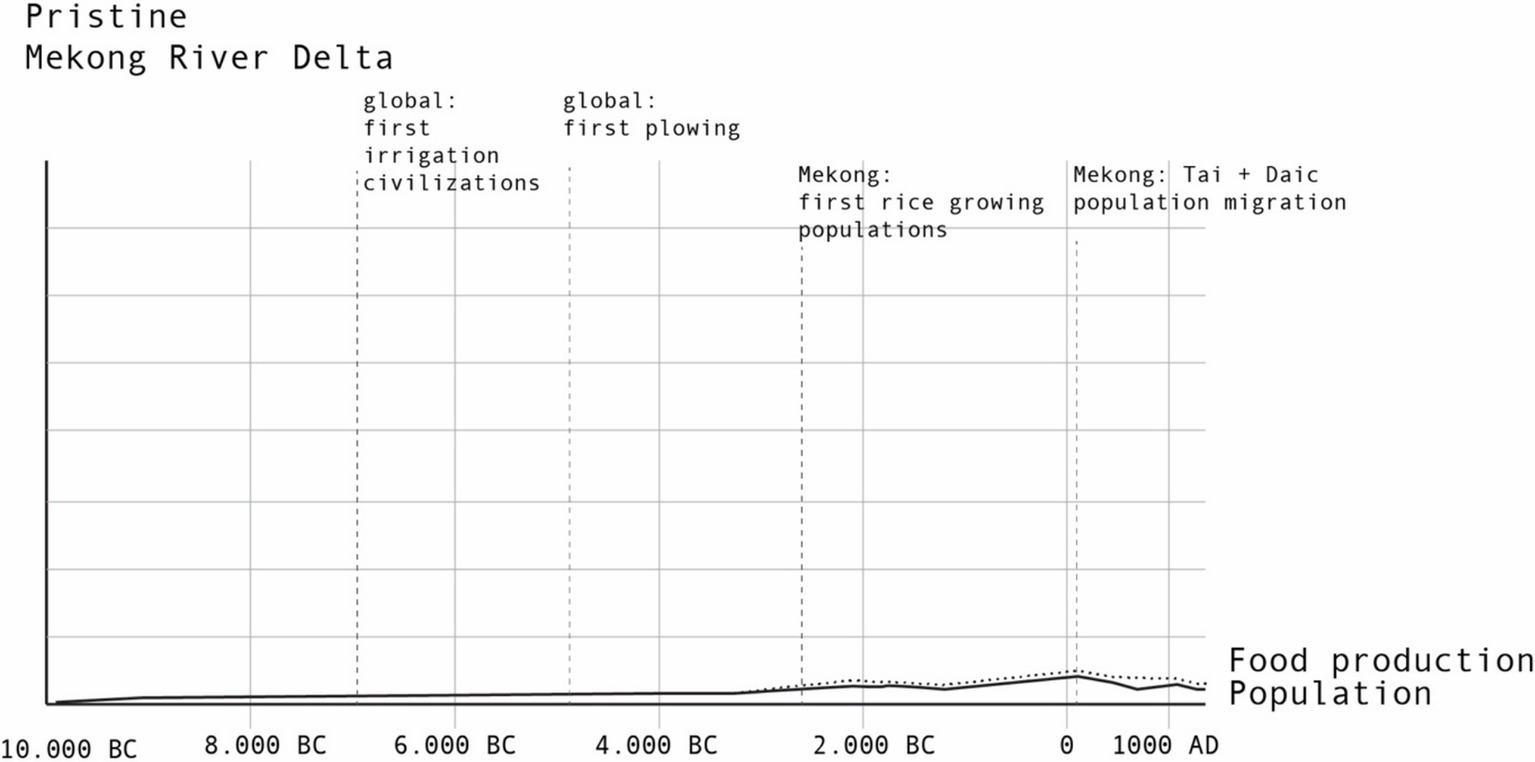
Figure 3. Food equation in pristine time based on textual information from Cramb (2020b), Drucker (1966), and Trần (2019).
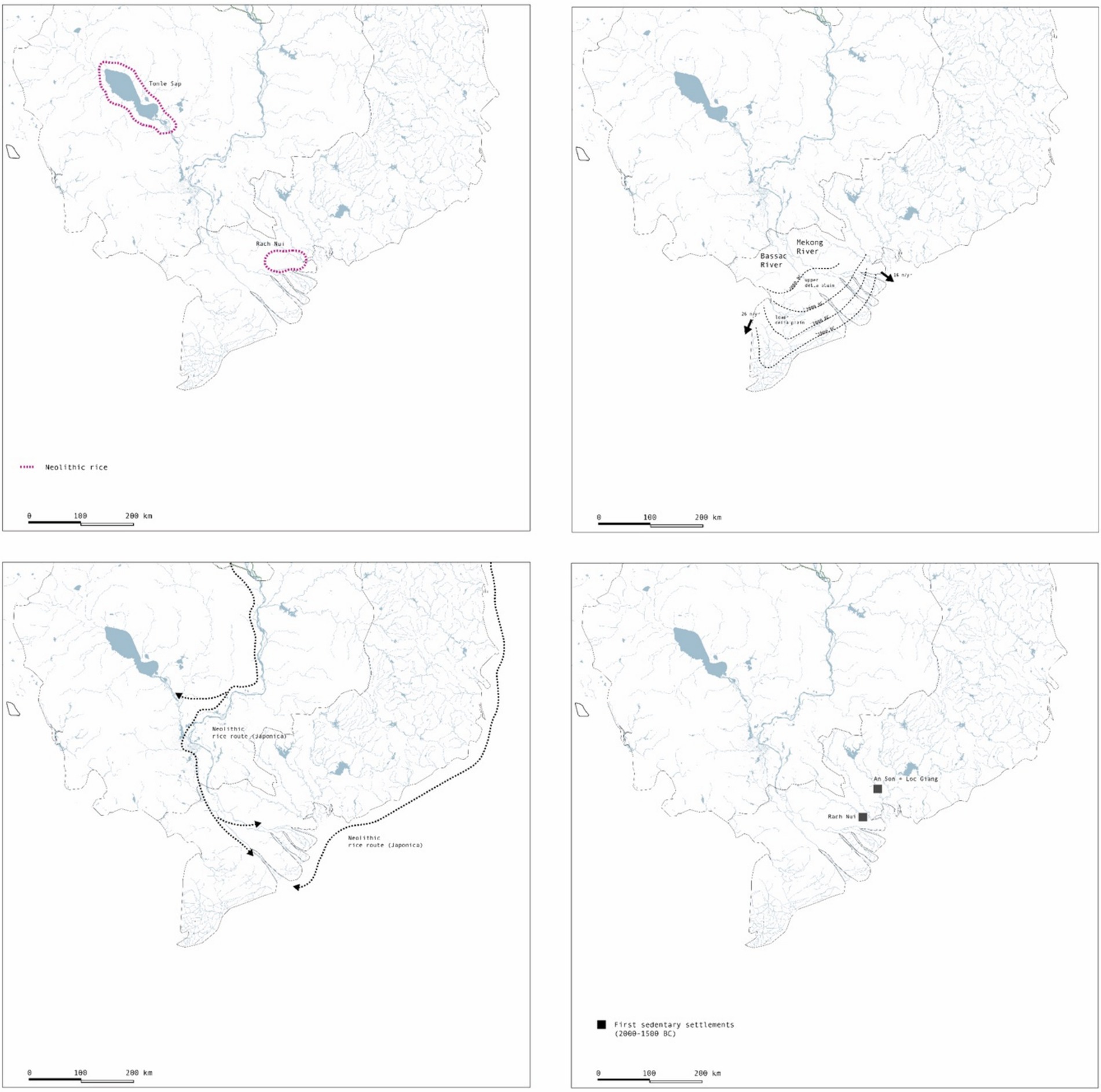
Figure 4. Pristine delta layers on rice croplands, deltaic systems, and trends in transportation, movement, and urbanization. Compiled with data from Castillo et al. (2018), Cramb (2020b), Piper and Oxenham (2014), and adapted from Zoccarato et al. (2018), licensed under CC BY 4.0.
3.1.2 Historic (1450–1850)
An important change that occurred during medieval times was the emergence of urban civilization. Along with the towns, markets became the primary agents of rural change during this period (Braudel, 1979; Steel, 2013). The concentration of cultivated land was no longer solely determined by environmental conditions but also by economic factors, which loosened the ties to the peasant world and brought crop cultivation and intensive farming closer to the city. Von Thünen’s abstract model for agricultural land use in “The Isolated State” (1826) aims to spatialize this relationship (von Thünen, 1826).
Assuming a settlement is centrally located, and all surrounding areas are equally accessible by oxcart, he developed a land use model. Four rings of agricultural activity encircle the city, with the closest ring dedicated to intensive farming and dairying for easy access to the city and market, followed by wood production for energy. The last two layers consist of extensive field crops, and the outermost layer focuses on ranching and animal products.
These initial conditions change when the settlement is connected to a navigable river (see Figure 5). Since this study focuses on deltaic areas, the modified conditions, with the navigable river included as part of the central settlement, influence the cropland areas in deltas. Particularly in larger rivers, the water does not form part of the settlement layout; instead, settlements develop along a smaller waterway that is affected by the course and depth of the river (Hooimeijer F. et al., 2021). This phenomenon is also evident in the transportation and urbanization layer of the Mekong Delta (Figure 6).
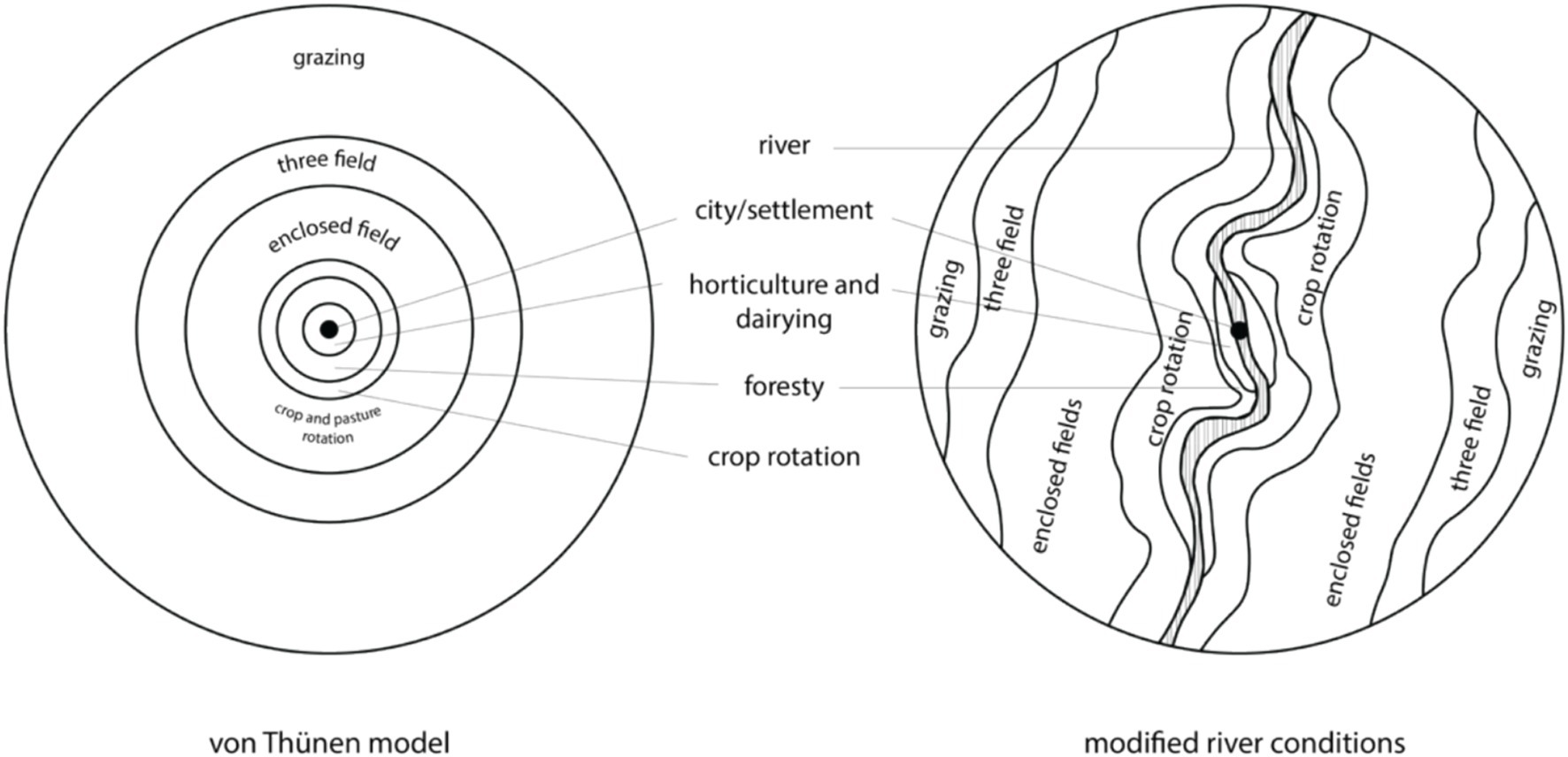
Figure 5. Von Thünen’s model (left) and the modified river conditions (right); reinterpreted from von Thünen, 1826 and Bieleman, 2010).
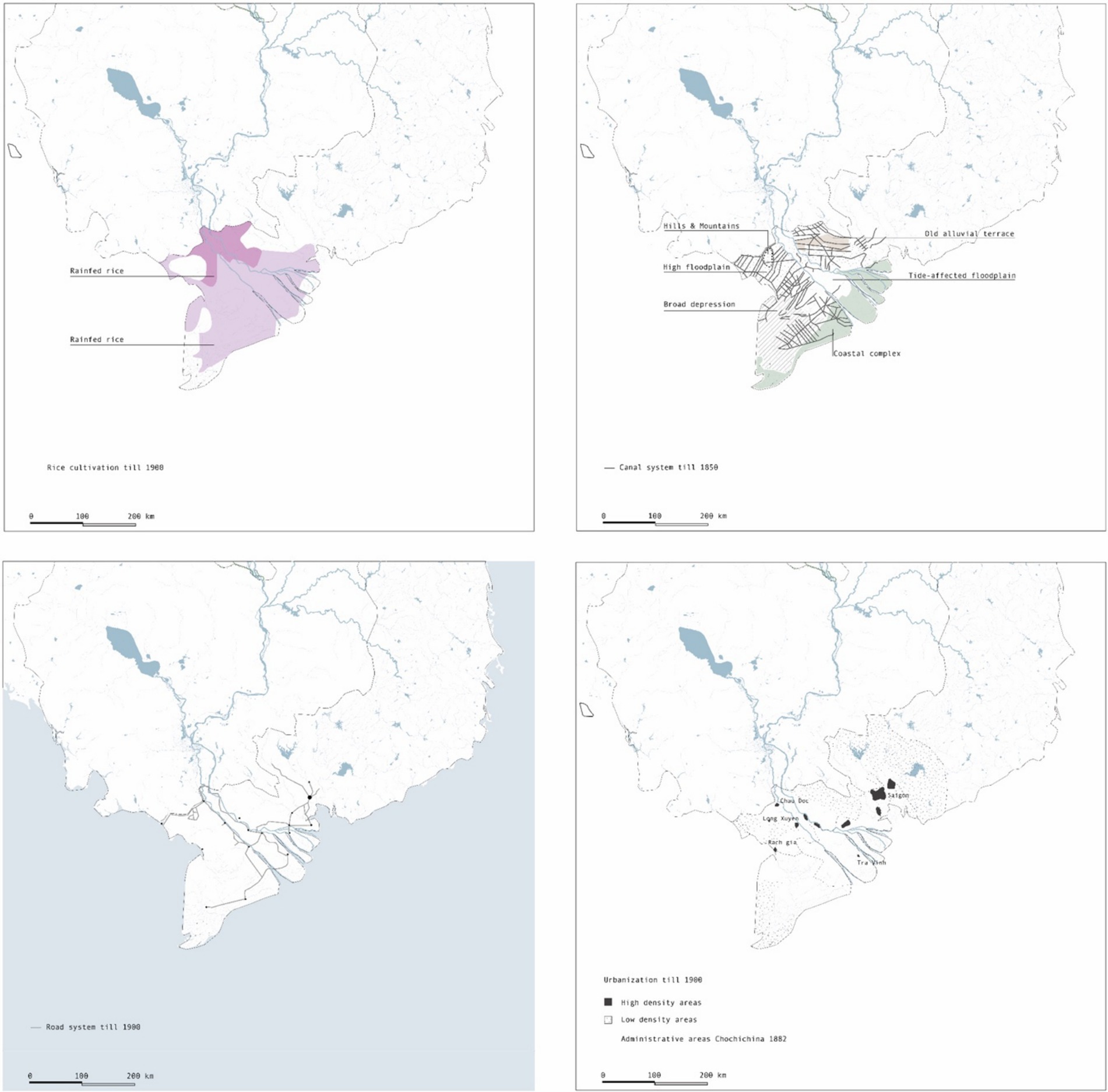
Figure 6. Historic delta layers on rice croplands, deltaic systems, transportation and movement patterns, and urbanization trends. Compiled with data from Kim Son (1998) and adapted from Pham and Pham (2011), licensed under CC BY 4.0.
In the case of the Mekong Delta, the post-Angkor period, spanning from the early 15th century to the late 1880s during French control, is accompanied by limited data regarding its spatial development, including the significant transformation in irrigation development that occurred during French colonization (Biggs, 2009) (Figure 7).
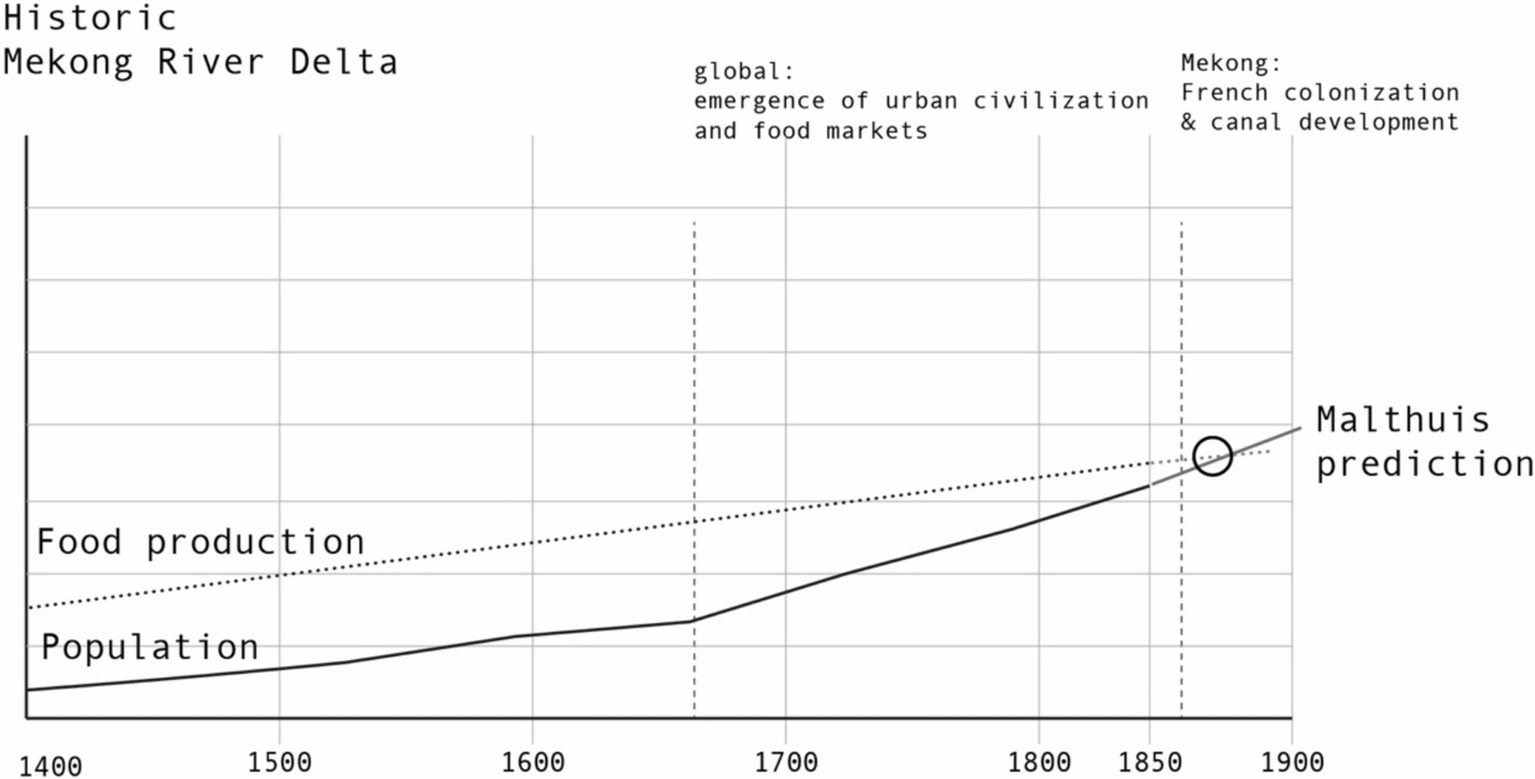
Figure 7. Historical layer, food equation as described in Biggs (2009).
3.1.3 Present (1850s – today)
The present layer focuses on the period after the 1850s, when major infrastructural developments, accompanied by technological inventions, changed the relationship between food production territories and densely populated areas. For example, the invention of refrigeration machines and the global refrigerated supply chain eliminated the need for direct proximity to settlements (Heard and Miller, 2016), while the development of rail transportation networks and steam vessels enabled fresh produce to be sourced from distant localities at a relatively low transport costs. In many cases, local land, labor and resource extraction were replaced by those from elsewhere, making a clear shift from Braudel’s “crops of civilization” to the “crops of globalization.”
Deltaic areas, among the most fertile lands and located at the crossroads of sea and land transportation, quickly became major importers and exporters of agricultural products on a global scale. By the end of the 1820s, the agricultural hinterland of the Mississippi River Delta supplied New Orleans with food and farm products. The rapid expansion of steamboats provided low transport rates and stimulated agricultural production, aiming to create a surplus for export to other U.S. coastal areas and overseas (Redard, 1985). In the Netherlands, exports from the Dutch delta began a few decades later, around 1850, and by 1910, it was estimated that half of the country’s agricultural and horticultural products were exported (Bieleman, 2010).
Urbanization and industrialization processes were followed by the Green Revolution in agriculture, generating new social, ecological, and spatial reconfigurations. The previously mentioned “crops of civilization, “along with soy, have expanded from providing food for local populations in the deltas to becoming staples in the globalization of the contemporary food system, no longer tied to the local territories that once produced them. Unlike the previous historical period when agricultural land and cities were closely linked, currently, food production lands are detached from localities as well as urban areas, the locations where food consumption is at its highest. The new globalized conditions have once again altered the relationship between land and population concentration, redistributing not only consumption but also the production of dominant crops on a planetary scale, thus increasing social inequalities in productive territories and consumption patterns.
In the Mekong Delta, agricultural transformations occurred in two stages: first, during the development of advanced water management infrastructure from 1860 to 1930, when many canals were constructed under French colonial rule, and projects on Dutch dikes and saltwater dams were initiated (Hoanh et al., 2014). Second, this process continued with the onset of the Green Revolution around 1968 in Vietnam (Trần, 2019). Figure 8 highlights a key aspect of this stage in the Mekong Delta: the introduction of high-yield varieties and agrochemicals supported by rice-first policies. These transformations led to the country’s transition in 1989 from a rice importer to a rice exporter. Figure 9 shows the spatial aspect of the present delta.
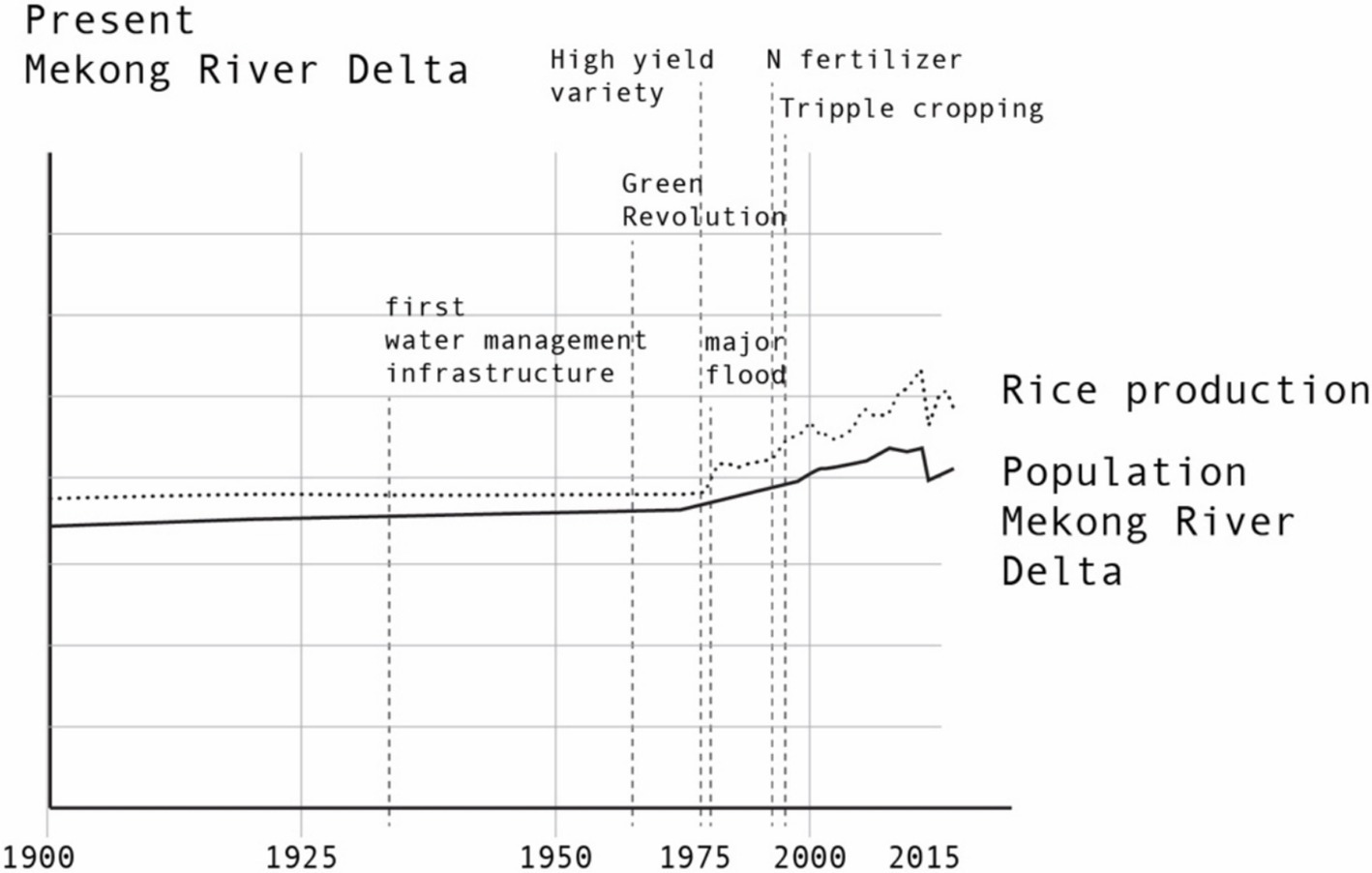
Figure 8. Present layer of rice production and population in the Mekong River Delta as described in Benedikter (2014) and Van Kien et al. (2020).
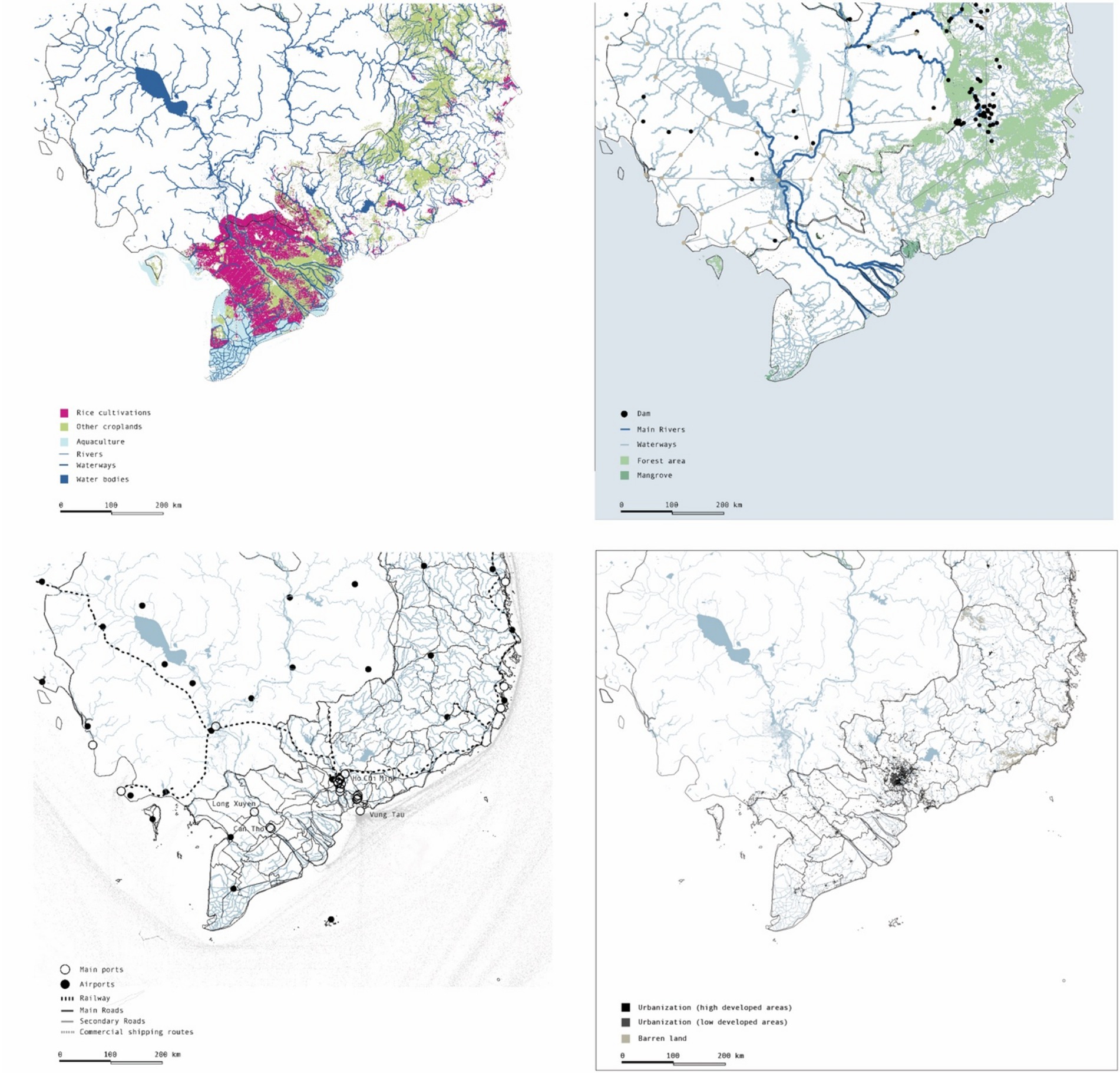
Figure 9. Present delta layers on rice croplands, deltaic systems, transportation/movement, and urbanization trends, based on data from the Advanced Land Observing Satellite (2024) and Open Development Mekong (2024).
3.2 Area scale: example of site 1, Ben Tre
Three zoom-in areas have been selected for detailed mapping analysis: the Ben Tre area, Can Tho, and Long Xuyen. A reciprocal approach, combining large-scale analysis with fieldwork, was used to identify these three zoom-in areas. They were chosen based on their diverse geographical conditions (coastal, central, and upper delta), which relate to various environmental challenges (salinity, flooding, and urbanization) and crop cultivation patterns (aqua-agriculture, extended urbanization, and flood zones). To illustrate the methodology, one of the case studies, the coastal site of Ben Tre, is presented in Figure 10. The zoom-in areas enable a deeper understanding of the spatial layers. For instance, the cropland layer includes different rice cropping patterns, ranging from single to triple cropping and aqua-agricultural practices.
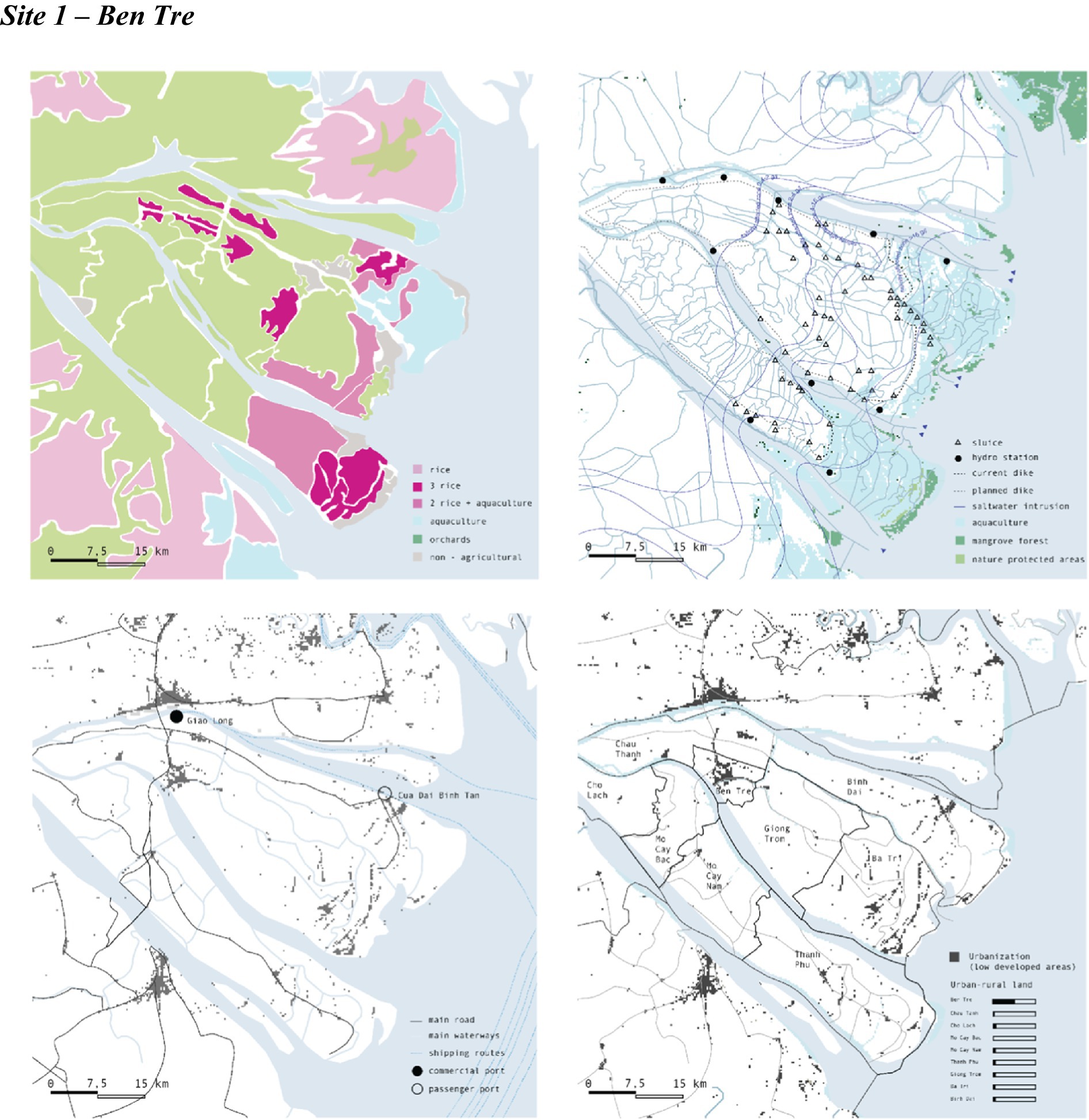
Figure 10. Ben Tre delta layers on rice croplands, deltaic system, transportation/movement, and urban–rural nexus. Adapted from Nam et al. (2023), licensed under CC BY 4.0 and World Bank (2018).
3.3 Local context scale
At a third level, the local context is addressed by incorporating representations such as sections and photographic materials from fieldwork (see Figures 11, 12).
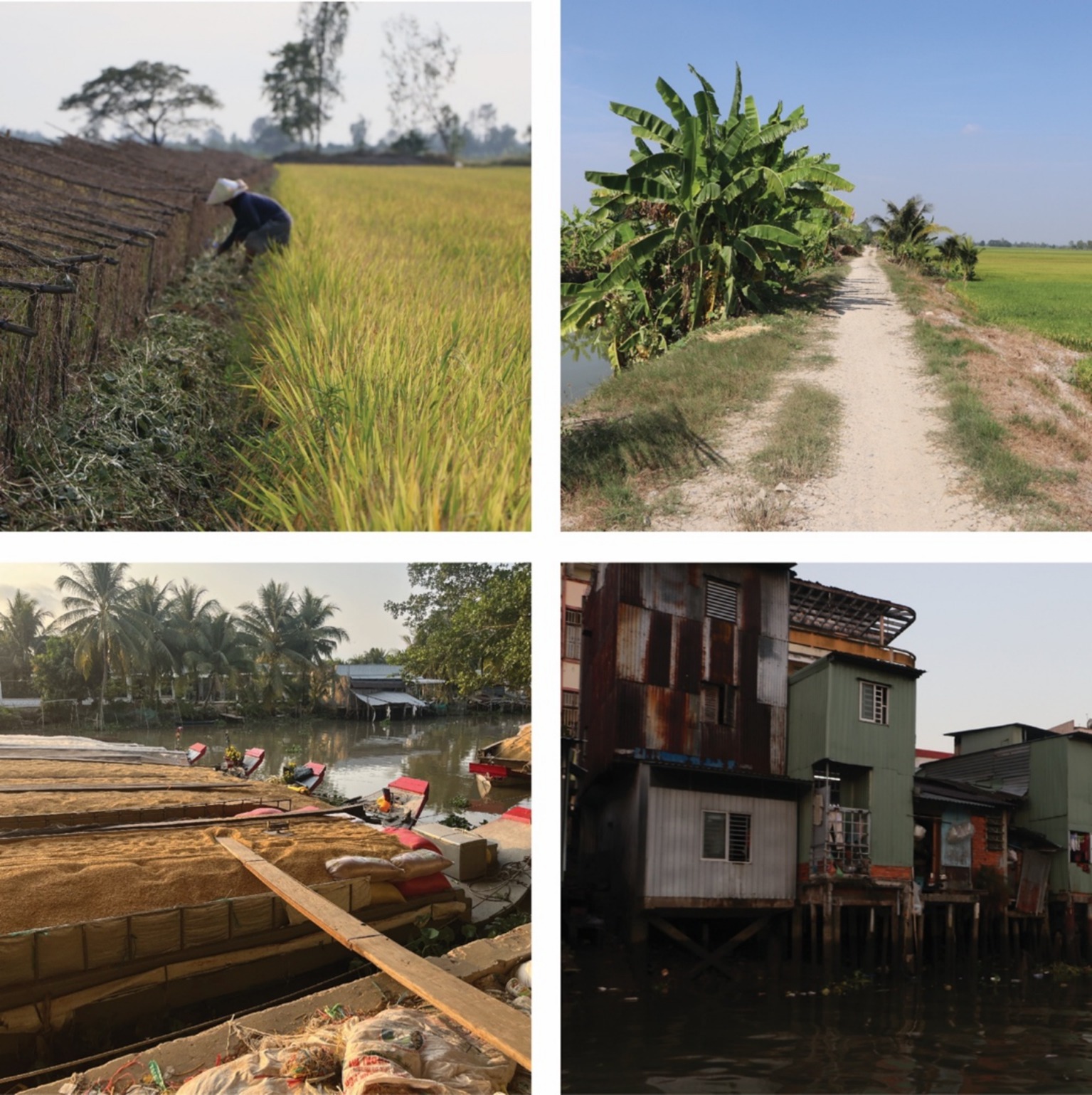
Figure 12. Images depicting the four layers illustrating the local context (croplands, deltaic system, transportation, urban–rural nexus).
3.4 Current perspective on the future of the Mekong River Delta
The representation of the future layer is not included in this research as it would require a thorough interpretation of the maps shown, which extends the scope of this study. However, the understanding of the broad past evolution of food and population dynamics, along with the necessity to revisit existing pathways on food and deltaic systems, leads to a reflection on a food/population equation. This is contextualized within the Mekong Delta context, primarily by revisiting official plans for future development (see Figure 13). Over the past years, especially due to environmental challenges and disparities between production costs and farmer income (Cramb, 2020a), a series of studies have been conducted in research, policy, and practice. In 2013, institutions, along with the Ministry of Natural Resources and Environment and the Ministry of Agriculture and Rural Development, introduced the Mekong Delta Plan, which was subsequently followed in 2020 by the Mekong Delta Integrated Regional Plan (The Socialist Republic of Vietnam and the Kingdom of the Netherlands, 2013, 2020).
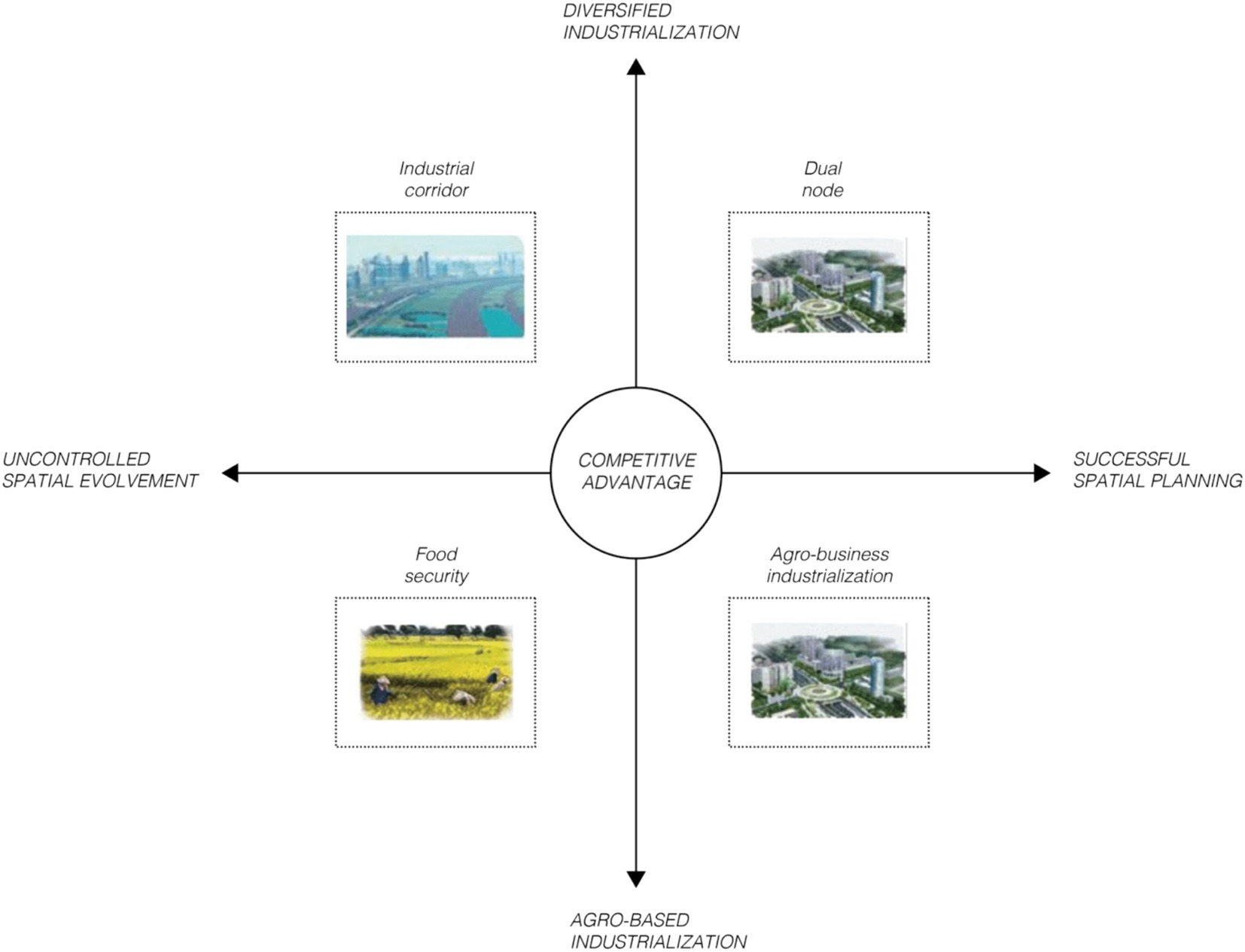
Figure 13. Pathways of the Mekong Delta Plan reconstructed from textual information in the Mekong Delta Plan, 2013.
Future pathways in the Mekong Delta plan of 2013 proposed four potential socioeconomic development paths: industrial corridor, dual node, food security, and agro-business industrialization (The Socialist Republic of Vietnam and the Kingdom of the Netherlands, 2013). The most prominent scenario was the agro-business industrialization plan, upon which the subsequent Mekong Delta Integrated Regional Plan (MDIRP) of 2020 was developed (Nguyen, 2023). This scenario aims to address environmental challenges while introducing an economic development approach inspired by more industrialized deltas.
The development plan highlights crucial topics for the area’s future and was created through collaboration with international institutions, mainly Dutch institutions and private partners. The Mekong Delta Plan and the MDRIP draw on the Dutch legacy and delta approach, incorporating both hard and soft infrastructure strategies (Nguyen, 2023).
The concept of knowledge transfer in Dutch water management and engineering expertise is a well-accepted notion in which policy models are transferred from technologically and institutionally advanced contexts to those that are less advanced, referred to as adopters (Hasan et al., 2019).
The Mekong Delta Integrated Regional Plan poses challenges and raises questions on two levels related to deltaic contexts and food. One level involves addressing how knowledge transfer and shared expertise incorporate local context specificity and integrate local practices (e.g., traditional farming systems and indigenous knowledge) (Hasan et al., 2019).
Simultaneously, the chosen pathway heavily depends on and enhances existing global market development trends, industrialization, and economic growth while raising unresolved critical questions about how current practices may exacerbate soil pollution, environmental degradation, and the social inclusion of smallholder farmers. Figure 14 explores this scenario and questions the feasibility of continuing along the suggested paths regarding food and deltas.
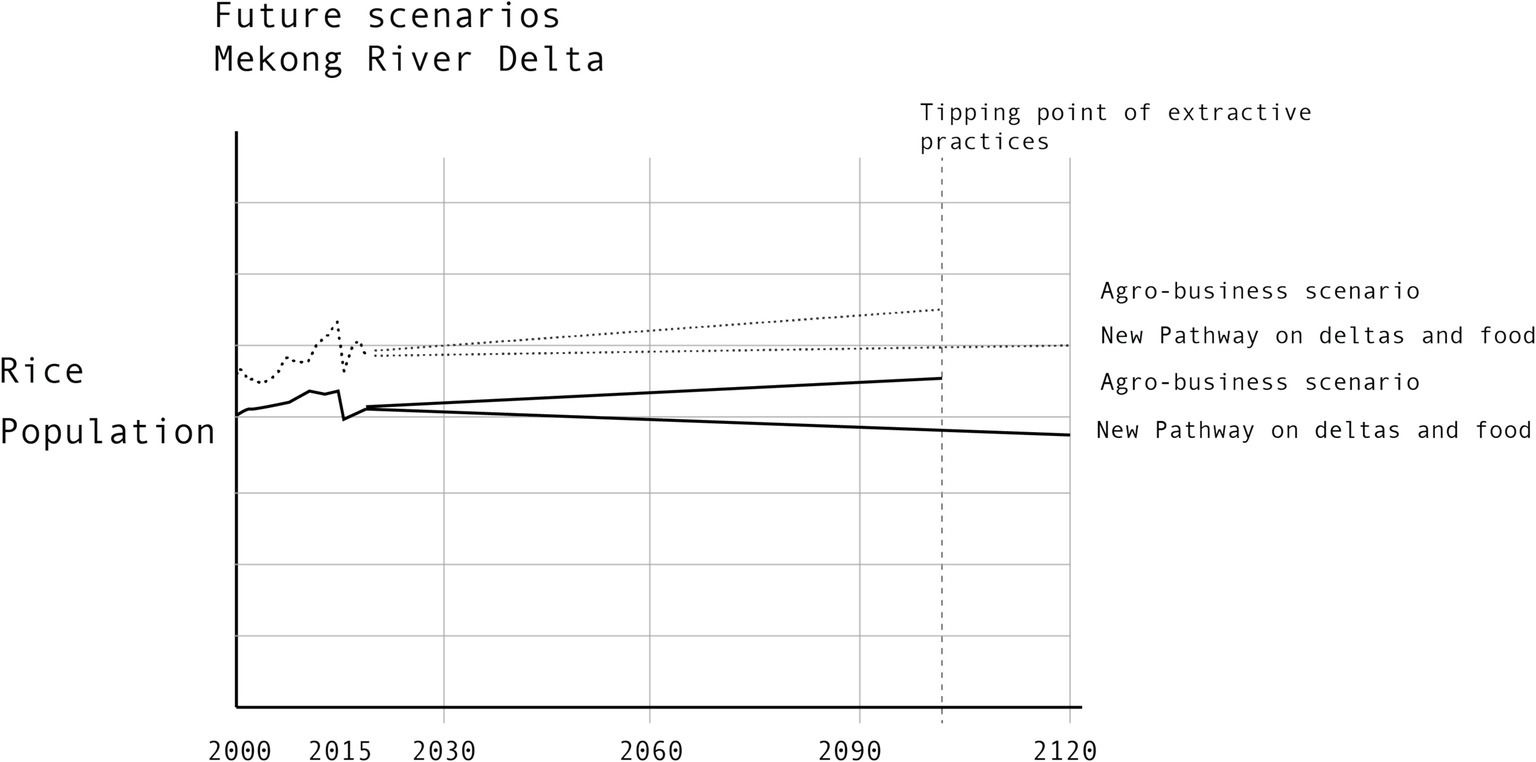
Figure 14. Future scenarios for rice production and population in the Mekong River Delta based on current and alternative strategies.
4 Reflection and discussion
4.1 Future pathways
When envisioning the future of food systems, several pathways emerge that can be broadly categorized into three main directions: the continuation of current practices, a technological fix, and a paradigm shift approach.
The first option envisions a continuation of extractive practices as they are currently conducted, with little to no action taken toward adapting to emerging technological advancements. Essentially, it aligns with Boserup and Simon’s food equation, a 20th-century concept suggesting that an increasing population leads to increased production (Soby, 2017).
The assumptions of Boserup and Simon may remain valid if no substantial changes occur in food systems. Food production could align with the increasing demand for nutrition due to population growth, supported by technological advancements. However, numerous studies suggest that a countdown has begun regarding the Earth’s carrying capacity if no transformation in the food system takes place, with its implications potentially unfolding more rapidly than climate change (Pfeiffer, 2006) (see Figure 14).
The second pathway is based on a more techno-positive assumption that the reliance of food production on land and the environment may be challenged by technological advancements and artificial conditions for crop growth. Undoubtedly, technological innovations impact the nature of agricultural production and expand its possibilities. These innovations enable higher yields and productivity with less labor. Global market demands require fewer crop varieties and prioritize greater production, emphasizing quantity over quality.
High-tech agriculture and automation are facilitating vertical farming, urban agriculture, and pocket farms, breaking down conceptual walls between the countryside, food production, and cities (Belleri and Ratti, 2023). Drones, artificial intelligence, and controlled-environment agriculture (such as indoor agriculture and vertical farming) utilizing soilless techniques (hydroponics, aquaponics, and aeroponics) enable crop growth in conditions outside traditional farms, which could significantly impact the spatial, economic, and social aspects of food systems. However, addressing these demands raises multiple questions, including spatial and ethical concerns (Mattei et al., 2018).
Some argue that while technological advancements have facilitated food production, the food crisis extends beyond merely technological and technocratic issues, rendering a solely techno-optimistic pathway unviable from multiple perspectives (Nat Food 2, 2021). These perspectives encompass both practical and ethical dimensions (Nat Food 2, 2021; Scott, 2011). The practical aspect highlights that past technological advancements (e.g., Golden Rice) have failed to resolve the fundamental problems of global hunger and have only exacerbated the current environmental crisis. The ethical aspect emphasizes how our existing methods of production are inherently tied to socio-cultural practices of land cultivation and spatial relationships. This line of argumentation aligns with the political ecology approach, emphasizing the complexities of socioecological systems in food and agriculture rather than simply proposing technical solutions (Jacobi et al., 2021). Alongside contemporary knowledge models that incorporate innovative techniques and advancements, local, cultural, and indigenous practices are equally vital in developing more sustainable food pathways (Nat Food 2, 2021).
In 2020, a group of experts—the editors of the International Assessment of Agricultural Knowledge, Science and Technology for Development (IAASTD), published in 2009—released research on the transformations of food systems, arguing that a paradigm shift is not only necessary but also urgent (Herren et al., 2020). Similarly, from a planning and design perspective, urbanism that adopts a transformative stance on how we shape our relationship with food has become a key part of academic discourse, with scholars advocating for agroecological urbanism (Tornaghi and Dehaene, 2021). Within this framework, it is important to examine potential pathways that align with spatial contexts and strategies for the territory while also addressing the systemic challenges of food production linked to local contexts. Food systems must consider the vast collective knowledge rooted in historical continuity within their territories while actively integrating the territories and natural systems. To date, food systems thinking, spatial design, and ecologies have not been well linked, and the concept of infrastructural assemblages within the framework of agroecological urbanism can serve as useful conceptual tools to align what have thus far been viewed as separate systems (Brown and Stigge, 2017; Roggema, 2016).
Linking food systems to spatial design and ecological thinking, the future spatial challenges of food territories are contextualized within deltaic areas and delta urbanism. This examination focuses on the convergences and synergies between future adaptation scenarios for deltaic systems and a transition in food systems (see Figure 15). Food production activities and their logistics in deltas depend on how well they are integrated into deltaic dynamics. To ensure that the critical functions of deltaic landscapes are preserved, human, natural, and productive ecosystems in deltas need to be better synergized (Syvitski et al., 2022). This can only occur if we align systems previously regarded as entirely separate within an integrated framework (Arbara et al., 2023). In the above paragraphs, we discussed a broad categorization of potential pathways for future food systems. Below, we will examine transition pathways through the lens of deltaic regions and adaptation scenarios to highlight the common operational ground between food systems and these adaptation scenarios. In coastal river deltas, adaptation scenarios are commonly agreed upon and categorized into three main types: protect, accommodate, and retreat (Bongarts Lebbe et al., 2021). Within these broad categorizations, a scenario focusing on accommodation, ecosystem-based adaptation, and nature-based solutions (Hooimeijer F. L. et al., 2021) is adopted as a framework in synergy with a paradigm shift in food systems. Thus, the theoretical and methodological approach is built upon the hypothesis of critically redesigning and aligning food system transitions with deltaic adaptation pathways. It primarily explores approaches linked to ecosystem-based adaptation and a regenerative model for diversified agroecological systems.
5 Potentials and limitations
The agroecological framework for delta urbanism can be valuable for the research community. It provides a historical perspective to trace long-term, gradual transformational processes, as well as key moments and technological advancements that have reshaped the relationship between land, food, and population distribution. This framework addresses a multi-scalar spatial perspective through an adapted layers approach, emphasizing the need to understand both planetary dynamics and local context specificity to understand past dynamics and address future drivers of change.
Beyond advancing scientific discourse, efforts to shift food systems toward diversified land-use models that incorporate socio-environmental considerations have the potential to inform and collaborate with spatial planning policies at the international, national, and local levels. Urgent actions and comprehensive policy recommendations from organizations such as the FAO, the UN Food Systems Summit, and the Committee on World Food Security are needed, with the latter developing voluntary guidelines to support transformations in food systems and nutrition (HLPE, 2019). However, not all attempts succeed in addressing the challenges of food systems in achieving transformative change.
For example, critics have expressed concerns about the 2021 UN Food Systems Summit, suggesting that it could reinforce corporate control over food systems instead of promoting equitable and sustainable solutions (Canfield et al., 2021). In the case of the Mekong River Delta, stakeholders express worries that current policies do not adequately balance agricultural productivity with environmental risks (Berchoux et al., 2023).
In this context, design research can help identify entry points for change and facilitate dialogue across sectors to drive systemic transformations. Historically, design has played a crucial role in shaping long-term spatial visions. Therefore, as suggested by Zevenbergen et al. (2024), design serves as a valuable tool for envisioning possible futures in a systemic manner and fostering dialogue across sectors and disciplines (Arbara et al., 2023).
This research is not without limitations. Its focus on establishing the conceptual and methodological foundations of the proposed framework came at the expense of presenting extensive empirical findings regarding the Mekong River Delta and rice cultivation. The study is limited to proposing and testing this framework at a preliminary level; therefore, further research to explore and discuss the empirical data is essential. Consistency in data also poses a challenge in this research—the broad chronological exploration complicates the use of the same data sources across periods, potentially affecting the readability of the maps. Finally, in addition to further examining the selected case study to enhance understanding of delta landscapes and food systems, a comparative analysis of case studies in major deltas (Mississippi, Rhine-Meuse, Nile, Paraná) and key crops (maize, potatoes, wheat, soy) could significantly improve the study’s applicability. Figure 16 depicts food-producing deltaic areas worldwide that can be analyzed through this framework and highlights the vulnerabilities in major deltaic agricultural systems involving rice, potatoes, maize, wheat, and soy cultivation.
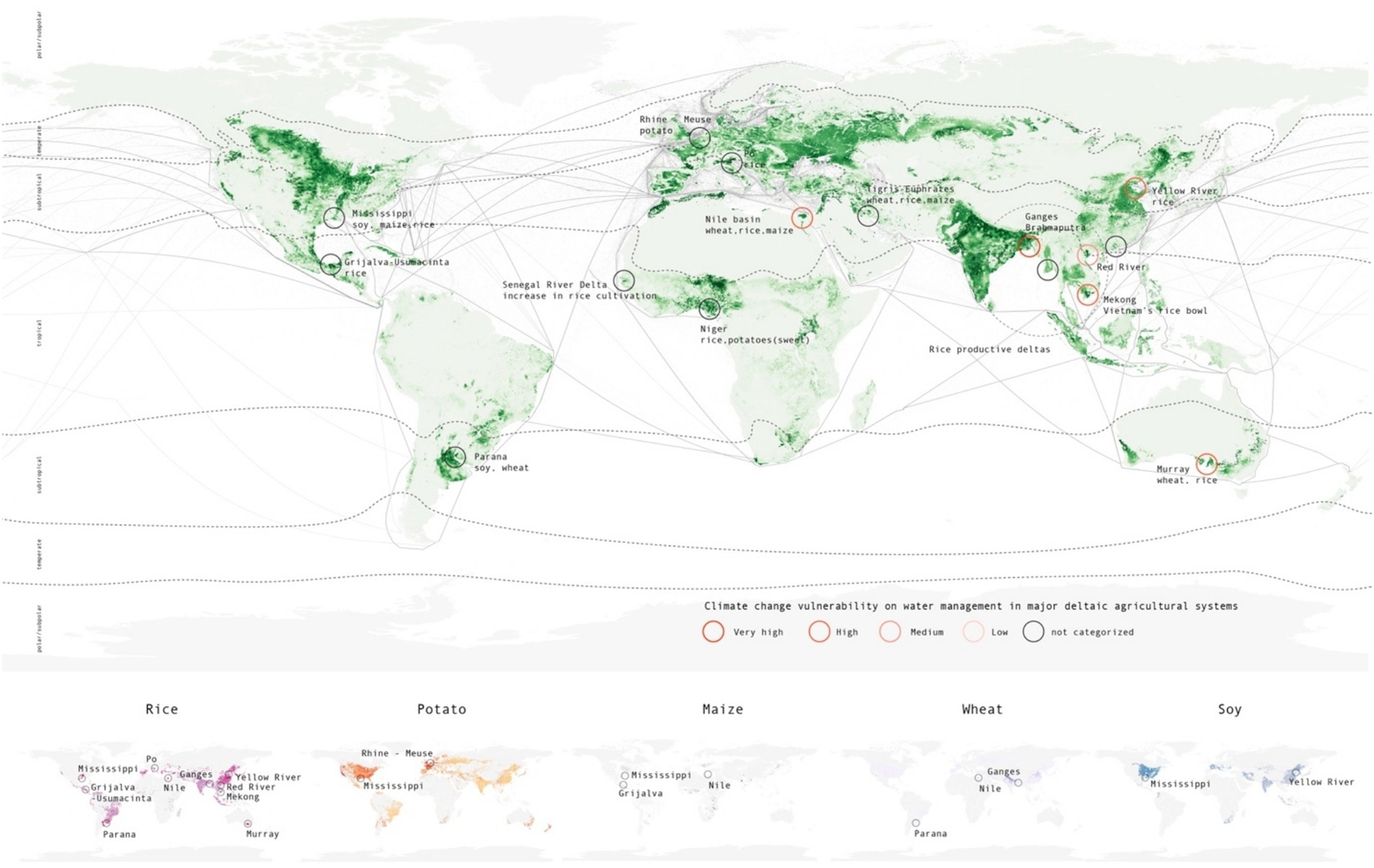
Figure 16. Major crops and climate change vulnerability in deltaic agricultural systems based on data from various sources (Turral et al., 2011).
6 Conclusion
An analysis of long-term transformations in deltas, along with technological advancements, environmental challenges, and landuse alterations over time, highlights the interrelated dynamics between agricultural production, industrial development, and ecosystem fragility. It also identifies key moments of significant shifts and spatial transformations. An initial synergy between productive landscapes, land, and civilizations gradually transitioned into a separation of production and consumption landscapes. As illustrated by von Thünen’s model, these changes initially occurred at the city and settlement scale and expanded following industrialization and the development of monocultures, seed monopolies, pesticides, and the refrigeration chain on a global scale.
The methodological and conceptual agroecological framework for delta urbanism presented in this study aims to synergize food systems research and spatial design with studies on delta urbanism, fostering a more sustainable future for food systems in deltas. To develop this framework, theories and methods were integrated to reconceptualize, analyze, and reconfigure the relationships between land, delta infrastructure, and food systems. The first step involved critically revisiting the fundamentals of food systems and addressing unsustainable practices from the perspectives of both food systems and deltaic systems.
The integrated methodological approach has been presented through the Mekong case study and rice cultivation croplands, aiming to serve as a reference for analyzing the spatial dynamics of deltas and food. This study highlights the reasons and methods behind our study, seeking to establish the foundation for systemic and long-term transformation of the pressing socioecological inquiry into resources and climate adaptation.
Data availability statement
The original contributions presented in the study are included in the article/supplementary material, further inquiries can be directed to the corresponding author.
Author contributions
SA: Conceptualization, Investigation, Methodology, Visualization, Writing – original draft, Writing – review & editing, Formal analysis. FH: Conceptualization, Formal analysis, Investigation, Methodology, Supervision, Writing – original draft, Writing – review & editing.
Funding
The author(s) declare that no financial support was received for the research and/or publication of this article.
Conflict of interest
The authors declare that the research was conducted in the absence of any commercial or financial relationships that could be construed as a potential conflict of interest.
Publisher’s note
All claims expressed in this article are solely those of the authors and do not necessarily represent those of their affiliated organizations, or those of the publisher, the editors and the reviewers. Any product that may be evaluated in this article, or claim that may be made by its manufacturer, is not guaranteed or endorsed by the publisher.
References
Addie, J.-P. D., Glass, M. R., and Nelles, J. (2019). Regionalizing the infrastructure turn: a research agenda. Reg. Stud. Reg. Sci. 7, 10–26. doi: 10.1080/21681376.2019.1701543
Arbara, S., Longhin, E., Chereni, S., Naghibi, M., Iuorio, L., Goncalves, J., et al. (2023). Prospects for inquiry in Delta urbanism research by design. J. Delta Urbanism 4:7521. doi: 10.59490/jdu.4.2023.7521
Barthel, S., Isendahl, C., Vis, B. N., Drescher, A., Evans, D. L., and Van Timmeren, A. (2019). Global urbanization and food production in direct competition for land: leverage places to mitigate impacts on SDG2 and on the earth system. Anthr. Rev. 6, 71–97. doi: 10.1177/2053019619856672
Battersby, J., Brown-Luthango, M., Fuseini, I., Gulabani, H., Haysom, G., Jackson, B., et al. (2023). Bringing together urban systems and food systems theory and research is overdue: understanding the relationships between food and nutrition infrastructures along a continuum of contested and hybrid access. Agric. Hum. Values 41:437, –448. doi: 10.1007/s10460-023-10507-6
Batty, M., and Torrens, P. M. (2001). Modelling complexity: the limits to prediction. Cybergeo: Eur. J. Geography. 201. doi: 10.4000/cybergeo.1035
Belleri, D., and Ratti, C. (2023). Urban farming: the reluctant utopia. Archit. Des. 93, 14–21. doi: 10.1002/ad.2889
Benedikter, S. (2014). Extending the hydraulic paradigm: Reunification, state consolidation, and water control in the Vietnamese Mekong Delta after 1975. Southeast Asian Stu. 3, 547–587. doi: 10.20495/seas.3.3_547
Berchoux, T., Hutton, C. W., Hensengerth, O., Voepel, H. E., Tri, V. P. D., Vu, P. T., et al. (2023). Effect of planning policies on land use dynamics and livelihood opportunities under global environmental change: Evidence from the Mekong Delta. Land Use Policy 131:106752. doi: 10.1016/j.landusepol.2023.106752
Bieleman, J. (2010). Five centuries of farming: A short history of Dutch agriculture 1500–2000. Wageningen: Wageningen Academic Publishers.
Biggs, D. (2009). The delta machine: Water management in the Vietnamese Mekong Delta in historical and contemporary perspectives. Copenhagen: NIAS Press.
Boehnert, J. (2018). Design, ecology, politics: Towards the Ecocene. 1st Edn. London: Bloomsbury Publishing Plc.
Bongarts Lebbe, T., Rey-Valette, H., Chaumillon, É., Camus, G., Almar, R., Cazenave, A., et al. (2021). Designing coastal adaptation strategies to Tackle Sea level rise. Front. Mar. Sci. 8:740602. doi: 10.3389/fmars.2021.740602
Boserup, E. (1965). The conditions of agricultural growth: The economics of agrarian change under population pressure. London: Aldine Pub. Co.
Braudel, F. (1958). Histoire et Sciences sociales: La longue durée. Annales Histoire Sci. Soc. 13, 725–753. doi: 10.3406/ahess.1958.2781
Braudel, F. (1979). Civilization and capitalism, 15th-18th century, Volume_I. Berkeley, CA: University of California Press.
Brown, H. (2019). Infrastructural ecology: embedding resilience in public works. Public Works Manag. Policy 24, 20–32. doi: 10.1177/1087724X18784602
Brown, H., and Stigge, B. (2017). Infrastructural ecologies: Alternative development models for emerging economies. London: The MIT Press.
Campanella, R. (2014). Fluidity, rigidity and consequence: a comparative historical geography of the Mississippi and Sénégal River deltas and the deltaic urbanism of New Orleans and Saint-Louis. Built Environ. 40, 184–200. doi: 10.2148/benv.40.2.184
Canfield, M., Anderson, M. D., and McMichael, P. (2021). UN Food systems summit 2021: dismantling democracy and resetting corporate control of Food systems. Front. Sust. Food Syst. 5:661552. doi: 10.3389/fsufs.2021.661552
Cardoch, L., Day, J. W., and Ibàñez, C. (2002). Net primary productivity as an Indicator of sustainability in the Ebro and Mississippi deltas. Ecol. Appl. 12, 1044–1055. doi: 10.2307/3061035
Castillo, C. C., Fuller, D. Q., Piper, P. J., Bellwood, P., and Oxenham, M. (2018). Hunter-gatherer specialization in the late Neolithic of southern Vietnam – the case of Rach Nui. Quat. Int. 489, 63–79. doi: 10.1016/j.quaint.2016.11.034
Cederberg, C., and Sonesson, U. (2011). “Global food losses and food waste: extent, causes and prevention; study conducted for the international congress save Food! At Interpack 2011, Düsseldorf, Germany” in International congress save Food. ed. J. Gustavsson (Rome: Food and Agriculture Organization of the United Nations).
Cramb, R. (2020a). “Issues of Rice policy in the lower Mekong Basin” in White gold: The commercialisation of Rice farming in the lower Mekong Basin. ed. R. Cramb (Cham: Springer Nature), 425–456.
Cramb, R. (2020b). “The evolution of Rice farming in the lower Mekong Basin” in White gold: The commercialisation of Rice farming in the lower Mekong Basin. ed. R. Cramb (Singapore: Springer Nature Singapore), 3–35.
Dammers, E., Bregt, A. K., Edelenbos, J., Meyer, H., and Pel, B. (2014). Urbanized deltas as complex adaptive systems: implications for planning and design. Built Environ. 40, 156–168. doi: 10.2148/benv.40.2.156
Day, J. W., Martin, J. F., Cardoch, L., and Templet, P. H. (1997). System functioning as a basis for sustainable management of deltaic ecosystems. Coast. Manag. 25, 115–153. doi: 10.1080/08920759709362315
de Hoog, M., Sijmons, D., and Verschuren, S. (1998). “Herontwerp van het Laagland [re-design of the low lands.]” in In Het Metropolitante Debat [The Metropolitan Debate]. ed. J. Blom (Bussum: THOTH).
Drucker, P. F. (1966). The first technological revolution and its lessons. Technol. Cult. 7, 143–151. doi: 10.2307/3102079
Fornasiero, A., Wing, R. A., and Ronald, P. (2022). Rice domestication. Curr. Biol. 32:25. doi: 10.1016/j.cub.2021.11.025
Gladek, E., Fraser, M., Roemers, G., Muñoz, O. S., Hirsch, P., and Kennedy, E. (2017). The global food system: An analysis. Utrecht: Metabolic & WWF Netherlands.
Grafton, R. Q., and Fanaian, S. (2023). Responding to the global challenges of ‘too much, too little and too dirty’ water: towards a safer and more just water future. Notas Económicas 56, 65–90. doi: 10.14195/2183-203X_56_3
Graham, S., and Marvin, S. (2001). Splintering urbanism. Networked infrastructures, technological mobilities and the urban condition. London: Routledge.
Graham, S., and Marvin, S. (2022). Splintering urbanism at 20 and the “infrastructural turn. J. Urban Technol. doi: 10.1080/10630732.2021.2005934
Hammer, E. (2022). Multi-centric, marsh-based urbanism at the early Mesopotamian city of Lagash (tell al-Hiba, Iraq). J. Anthropol. Archaeol. 68:101458. doi: 10.1016/j.jaa.2022.101458
Hara, Y., Takeuchi, K., and Okubo, S. (2005). Urbanization linked with past agricultural landuse patterns in the urban fringe of a deltaic Asian mega-city: a case study in Bangkok. Landsc. Urban Plan. 73, 16–28. doi: 10.1016/j.landurbplan.2004.07.002
Hasan, S., Evers, J., Zegwaard, A., and Zwarteveen, M. (2019). Making waves in the Mekong Delta: recognizing the work and the actors behind the transfer of Dutch delta planning expertise. J. Environ. Plan. Manag. 62, 1583–1602. doi: 10.1080/09640568.2019.1592745
Heard, B. R., and Miller, S. A. (2016). Critical research needed to examine the environmental impacts of expanded refrigeration on the Food system. Environ. Sci. Technol. 50, 12060–12071. doi: 10.1021/acs.est.6b02740
Herren, H. R., and Haerlin, B.IAASTD+10 Advisory Group, C (2020). Transformation of our food systems. The making of a paradigm shift. Berlin: Zukunftsstiftung Landwirtschaft & Biovision.
Higgins, S., Rogers, K., Syvitski, J., Overeem, I., and Gilligan, J. (2013). “Farming practices and anthropogenic delta dynamics,” in IAHS-AISH proceedings and reports, Vol. 358.
HLPE (2019). Agroecological and other innovative approaches for sustainable agriculture and food systems that enhance food security and nutrition. A report by the high level panel of experts on Food security and nutrition of the committee on world Food security. Rome: HLPE.
Hoanh, C. T., Suhardiman, D., and Anh, L. T. (2014). Irrigation development in the Vietnamese Mekong Delta: towards polycentric water governance? Int. J. Water Gov. 2, 61–82. doi: 10.7564/14-IJWG59
Hooimeijer, F., Bacchin, T. K., and Kothuis, B. (2021). Longue Durée. J. Delta Urb. 2, 4–11. doi: 10.48438/jdu.2.2021.6222
Hooimeijer, F. L., Kuzniecow Bacchin, T., Recubenis Sanchis, I., Di Gioia, M., Ferreira, L., and Do Nascimento, L. F. (2021). NBS in vulnerable geographies. Delft: Delft University of Technology.
Hooimeijer, F. L., Lafleur, F., and Trinh, T. T. (2017). Drawing the subsurface: an integrative design approach. Procedia Eng. 209, 61–74. doi: 10.1016/j.proeng.2017.11.131
Hunter, D., Guarino, L., Spillane, C., and McKeown, P. C. (2017). Routledge handbook of agricultural biodiversity. London: Routledge.
Jacobi, J., Villavicencio Valdez, G. V., and Benabderrazik, K. (2021). Towards political ecologies of food. Nat. Food 2, 835–837. doi: 10.1038/s43016-021-00404-8
Kim Son, D. (1998). “Production systems and farming Systems in the Mekong Delta,” in The 4th JIRCAS international symposium sustainable agricultural development compatible with environmental conservation in Asia.
Le Coq, J.-F., Dufumier, M., and Trébuil, G. (2001). History of rice production in the Mekong Delta. The third Euroseas conference. London: SOAS.
Liu, J., Wang, S., and Li, D. (2014). The analysis of the impact of land-use changes on flood exposure of Wuhan in Yangtze River basin, China. Water Resour. Manag. 28, 2507–2522. doi: 10.1007/s11269-014-0623-1
Malthus, T. R. (1798). An essay on the principle of population. London: History of Economic Thought Books.
Mattei, J. L. V.-P., Ferrando, T., and De Schutter, O. (2018). Routledge handbook of Food as a commons. London: Routledge.
McHarg, I. L. (1969). Design with nature. 1st Edn. New York, NY: American Museum of Natural History [by] the Natural History Press.
Meyer, H., and Nijhuis, S. (2010). Deltascapes—Towards a typology of urbanizing deltas [presentation] TU Delft.
Meyer, H., and Nijhuis, S. (2013). Delta urbanism: planning and design in urbanized deltas – comparing the Dutch delta with the Mississippi River delta. J. Urban. Int. Res. Placemaking Urban Sust. 6, 160–191. doi: 10.1080/17549175.2013.820210
Molina, M., Petersen, P., Peña, F., and Caporal, F. (2020). Political agroecology: Advancing the transition to sustainable Food systems. London: CRC Press.
Montano, B., and García-López, M. (2020). Malthusianism of the 21st century. Environ. Sust. Indic. 6:100032. doi: 10.1016/j.indic.2020.100032
Moragues-Faus, A., and Marsden, T. (2017). The political ecology of food: carving ‘spaces of possibility’ in a new research agenda. J. Rural. Stud. 55, 275–288. doi: 10.1016/j.jrurstud.2017.08.016
Nam, N. T., Thuc, P. T. B., Dao, D. A., Thien, N. D., Au, N. H., and Tran, D. D. (2023). Assessing climate-driven salinity intrusion through water accounting: a case study in Ben Tre Province for more sustainable water management plans. Sustain. For. 15:9110. doi: 10.3390/su15119110
Nat Food 2 (2021). The limits of a technological fix. Nat. Food 2:211. doi: 10.1038/s43016-021-00275-z
Nguyen, S. T. (2023). Atlas narratives of anthropogenic transformations across the Vietnamese Mekong Delta’s urban-rural territories: Water ecosystems as subject for the social ecological transition. Lausanne: EPFL.
Patel, R., and Moore, J. W. (2017). A history of the world in seven cheap things: A guide to capitalism, nature, and the future of the planet. Berkeley, CA: University of California Press.
Pfeiffer, D. (2006). Eating fossil fuels: Oil, Food, and the coming crisis in agriculture. Gabriola, BC: New Society.
Pham, D., and Pham, T. (2011). “Urbanizing Mekong Delta in Vietnam: the challenges of urban expansion adapting to floods,” in The 5th International Conference of the International Forum on Urbanism (IFoU).
Piper, P., and Oxenham, M. (2014). “Of prehistoric pioneers: the establishment of the first sedentary settlements in the Mekong Delta region of southern Vietnam during the period 2000-1500 cal. BC” in Living in the landscape: Essays in honour of Graeme barker. eds. K. Boyle, R. J. Rabett, and C. O. Hunt (Cambridge: McDonald Institute Monographs), 209–226.
Redard, T. E. (1985). The port of New Orleans: An economic history, 1821–1860. Baton Rouge, LA: Louisiana State University and Agricultural and Mechanical College.
Rogelja, I. (2020). Concrete and coal: China’s infrastructural assemblages in the Balkans. Polit. Geogr. 81:102220. doi: 10.1016/j.polgeo.2020.102220
Roggema, R. (2016). Research by design: proposition for a methodological approach. Urban Sci. 1:2. doi: 10.3390/urbansci1010002
Schneider, P., and Asch, F. (2020). Rice production and food security in Asian mega deltas—a review on characteristics, vulnerabilities and agricultural adaptation options to cope with climate change. J. Agron. Crop Sci. 206, 491–503. doi: 10.1111/jac.12415
Scott, D. (2011). The technological fix criticisms and the agricultural biotechnology debate. J. Agric. Environ. Ethics 24, 207–226. doi: 10.1007/s10806-010-9253-7
Soby, S. (2017). Thomas Malthus, Ester Boserup, and agricultural development models in the age of limits. J. Agric. Environ. Ethics 30, 87–98. doi: 10.1007/s10806-017-9655-x
Spirn, A. W. (2000). Ian McHarg, landscape architecture, and Enviroronmentalism: Ideas and methods in context. Washington, DC: Dumbarton Oaks Trustees for Harvard University.
Stott, P. A., and Sullivan, S. (2000). Political ecology: Science, Myth and Power. New York, NY: Oxford University Press.
Syvitski, J., Anthony, E., Saito, Y., Zăinescu, F., Day, J., Bhattacharya, J. P., et al. (2022). Large deltas, small deltas: toward a more rigorous understanding of coastal marine deltas. Glob. Planet. Chang. 218:103958. doi: 10.1016/j.gloplacha.2022.103958
Terwisscha van Scheltinga, C., Wilbers, G.-J., Islam, F., Debrot, D., Verburg, C., Naranjo Barrantes, M., et al. (2023). Food systems in the Bangladesh Delta: overview of food systems in Bangladesh with a focus on the coastal south west (3233). Wageningen: Wageningen Environmental Research. doi: 10.18174/580735
The Observatory of Economic Complexity. (2024). OEC. Available at: https://oec.world/en (Accessed March 11, 2025).
The Socialist Republic of Vietnam and the Kingdom of the Netherlands. (2013). Mekong delta plan: long-term vision and strategy for a safe, prosperous and sustainable. Netherlands: Partners for Water.
The Socialist Republic of Vietnam and the Kingdom of the Netherlands. (2020). Mekong Delta regional integrated plan (MDRIP). Royal HaskoningDHV in collaboration with the Vietnamese Ministry of Planning and Investment (MPI), the World Bank, GIZ, and Wageningen University & Research (WUR).
Tornaghi, E. C., and Dehaene, M. (2021). Resourcing an Agroecological urbanism; political, transformational and territorial dimensions. London: Routledge.
Turral, H., Burke, J., and Faures, J. M. (2011). Climate change, water and food security. Rome: FAO Water Reports.
Trần, V. Đ. (2019). ‘Sơ lược lịch sử trồng lúa Việt Nam’, Tập San Việt Học. Available at: https://tongphuochiep.com/index.php/bao-chi/l-ch-s/28902-so-lu-c-l-ch-s-tr-ng-lua-vi-t-nam-tr-n-van-d-t-ph-d (Accessed March 13, 2025).
van der Elsch, S., Bakkenes, M., Doelman, J., Stehfest, E., Langhans, C., and Bouwman, A. (2022). The global potential for land restoration: Scenarios for the global land outlook 2. The Hague: PBL Netherlands Environmental Asessment Agency.
van Der Meulen, G. J. M., van Dorst, M. J., and Kuzniecow Bacchin, T. (2023). Water sensitivity and context specificity – concept and context in water-sensitive Urban Design for secondary cities. Urban Water J. 20, 15–25. doi: 10.1080/1573062X.2022.2153704
Van Kien, N., Hoang Han, N., and Cramb, R. (2020). “Trends in Rice-based farming Systems in the Mekong Delta” in White gold: The commercialisation of Rice farming in the lower Mekong Basin. ed. R. Cramb (Singapore: Springer Nature Singapore), 347–373.
World Bank (2018). City resilience in the Mekong Delta: BEN TRE resilience assessment: technical study [text/HTML]. Washington, DC: World Bank.
Yuen, K., Hanh, T., Vu, Q., Switzer, A., Teng, P., and Lee, J. S. H. (2021). Interacting effects of land-use change and natural hazards on rice agriculture in the Mekong and Red River deltas in Vietnam. Nat. Hazards Earth Syst. Sci. 21, 1473–1493. doi: 10.5194/nhess-21-1473-2021
Zevenbergen, C., Harteveld, M. G., Bloemen, P., Van Ham, M., Van Den Doel, W., Hertogh, M. H., et al. (2024). Uniting imagination and evidence by design to navigate climate survival in urbanizing deltas. NPJ Ocean Sust. 3:53. doi: 10.1038/s44183-024-00094-2
Keywords: delta urbanism, food system transitions, research and design, agroecological urbanism, Mekong Delta, political ecology, infrastructural turn, Longue Durée
Citation: Arbara S and Hooimeijer F (2025) A conceptual framework for integrating deltaic food systems and spatial design: the case of the Mekong River Delta. Front. Sustain. Food Syst. 9:1466134. doi: 10.3389/fsufs.2025.1466134
Edited by:
Hubert Hirwa, Florida Agricultural and Mechanical University, United StatesReviewed by:
Abeni Beshiru, Federal Institute for Risk Assessment (BfR), GermanyYuchuan Fan, Mississippi State University, United States
Copyright © 2025 Arbara and Hooimeijer. This is an open-access article distributed under the terms of the Creative Commons Attribution License (CC BY). The use, distribution or reproduction in other forums is permitted, provided the original author(s) and the copyright owner(s) are credited and that the original publication in this journal is cited, in accordance with accepted academic practice. No use, distribution or reproduction is permitted which does not comply with these terms.
*Correspondence: Sophia Arbara, cy5hcmJhcmFAdHVkZWxmdC5ubA==
 Sophia Arbara
Sophia Arbara Fransje Hooimeijer
Fransje Hooimeijer